
DATA SHEET
Product specification
Supersedes data of 2002 Jun 06
2002 Sep 25
INTEGRATED CIRCUITS
TDA8920
2
×
80 W class-D power amplifier

2002 Sep 25
2
Philips Semiconductors
Product specification
2
×
80 W class-D power amplifier
TDA8920
CONTENTS
1
FEATURES
2
APPLICATIONS
3
GENERAL DESCRIPTION
4
ORDERING INFORMATION
5
QUICK REFERENCE DATA
6
BLOCK DIAGRAM
7
PINNING
8
FUNCTIONAL DESCRIPTION
8.1
General
8.2
Pulse width modulation frequency
8.3
Protections
8.3.1
Over-temperature
8.3.2
Short-circuit across the loudspeaker terminals
and to supply lines
8.3.3
Start-up safety test
8.3.4
Supply voltage alarm
8.4
Differential audio inputs
9
LIMITING VALUES
10
THERMAL CHARACTERISTICS
11
QUALITY SPECIFICATION
12
STATIC CHARACTERISTICS
13
SWITCHING CHARACTERISTICS
14
DYNAMIC AC CHARACTERISTICS (STEREO
AND DUAL SE APPLICATION)
15
DYNAMIC AC CHARACTERISTICS (MONO
BTL APPLICATION)
16
APPLICATION INFORMATION
16.1
BTL application
16.2
MODE pin
16.3
Output power estimation
16.4
External clock
16.5
Heatsink requirements
16.6
Output current limiting
16.7
Pumping effects
16.8
Reference design
16.9
PCB information for HSOP24 encapsulation
16.10
Classification
16.11
Reference design: bill of materials
16.12
Curves measured in the reference design
17
PACKAGE OUTLINE
18
SOLDERING
18.1
Introduction to soldering surface mount
packages
18.2
Reflow soldering
18.3
Wave soldering
18.4
Manual soldering
18.5
Suitability of surface mount IC packages for
wave and reflow soldering methods
19
DATA SHEET STATUS
20
DEFINITIONS
21
DISCLAIMERS
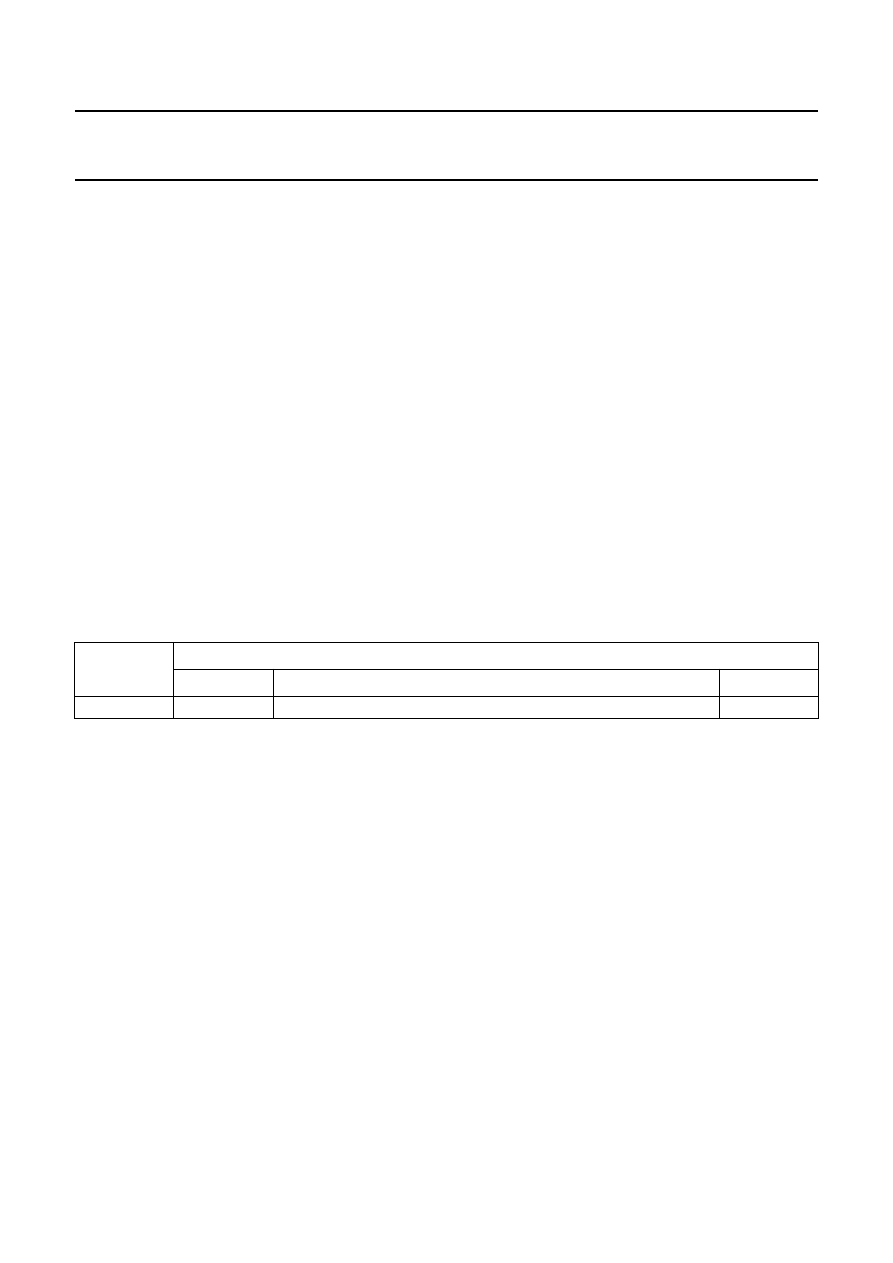
2002 Sep 25
3
Philips Semiconductors
Product specification
2
×
80 W class-D power amplifier
TDA8920
1
FEATURES
•
High efficiency (
∼
90%)
•
Operating voltage from
±
12.5 to
±
30 V
•
Very low quiescent current
•
Low distortion
•
Usable as a stereo Single-Ended (SE) amplifier or as a
mono amplifier in Bridge-Tied Load (BTL)
•
Fixed gain of 30 dB in Single-Ended (SE) and 36 dB in
Bridge-Tied Load (BTL)
•
High output power
•
Good ripple rejection
•
Internal switching frequency can be overruled by an
external clock
•
No switch-on or switch-off plop noise
•
Short-circuit proof across the load and to the supply
lines
•
Electrostatic discharge protection
•
Thermally protected.
2
APPLICATIONS
•
Television sets
•
Home-sound sets
•
Multimedia systems
•
All mains fed audio systems
•
Car audio (boosters).
3
GENERAL DESCRIPTION
The TDA8920 is a high efficiency class-D audio power
amplifier with very low dissipation. The typical output
power is 2
×
80 W. The device comes in a HSOP24 power
package with a small internal heatsink. Depending on
supply voltage and load conditions a very small or even no
external heatsink is required. The amplifier operates over
a wide supply voltage range from
±
12.5 to
±
30 V and
consumes a very low quiescent current.
4
ORDERING INFORMATION
TYPE
NUMBER
PACKAGE
NAME
DESCRIPTION
VERSION
TDA8920TH
HSOP24
plastic, heatsink small outline package; 24 leads; low stand-off height
SOT566-3

2002 Sep 25
4
Philips Semiconductors
Product specification
2
×
80 W class-D power amplifier
TDA8920
5
QUICK REFERENCE DATA
Note
1. See also Section 16.5.
SYMBOL
PARAMETER
CONDITIONS
MIN.
TYP.
MAX.
UNIT
General; V
P
=
±
25 V
V
P
operating supply voltage
±
12.5
±
25
±
30
V
I
q
quiescent current
no load connected
−
55
75
mA
η
efficiency
P
o
= 30 W; SE: R
L
= 2
×
8
Ω
; f
i
= 1 kHz
−
90
−
%
Stereo single-ended configuration
P
o
output power
R
L
= 8
Ω
; THD = 10%; V
P
=
±
25 V; note 1
36
39
−
W
R
L
= 4
Ω
; THD = 10%; V
P
=
±
27 V; note 1
74
80
−
W
Mono bridge-tied load configuration
P
o
output power
R
L
= 4
Ω
; THD = 10%; V
P
=
±
17 V; note 1
100
110
−
W
R
L
= 8
Ω
; THD = 10%; V
P
=
±
25 V; note 1
128
140
−
W
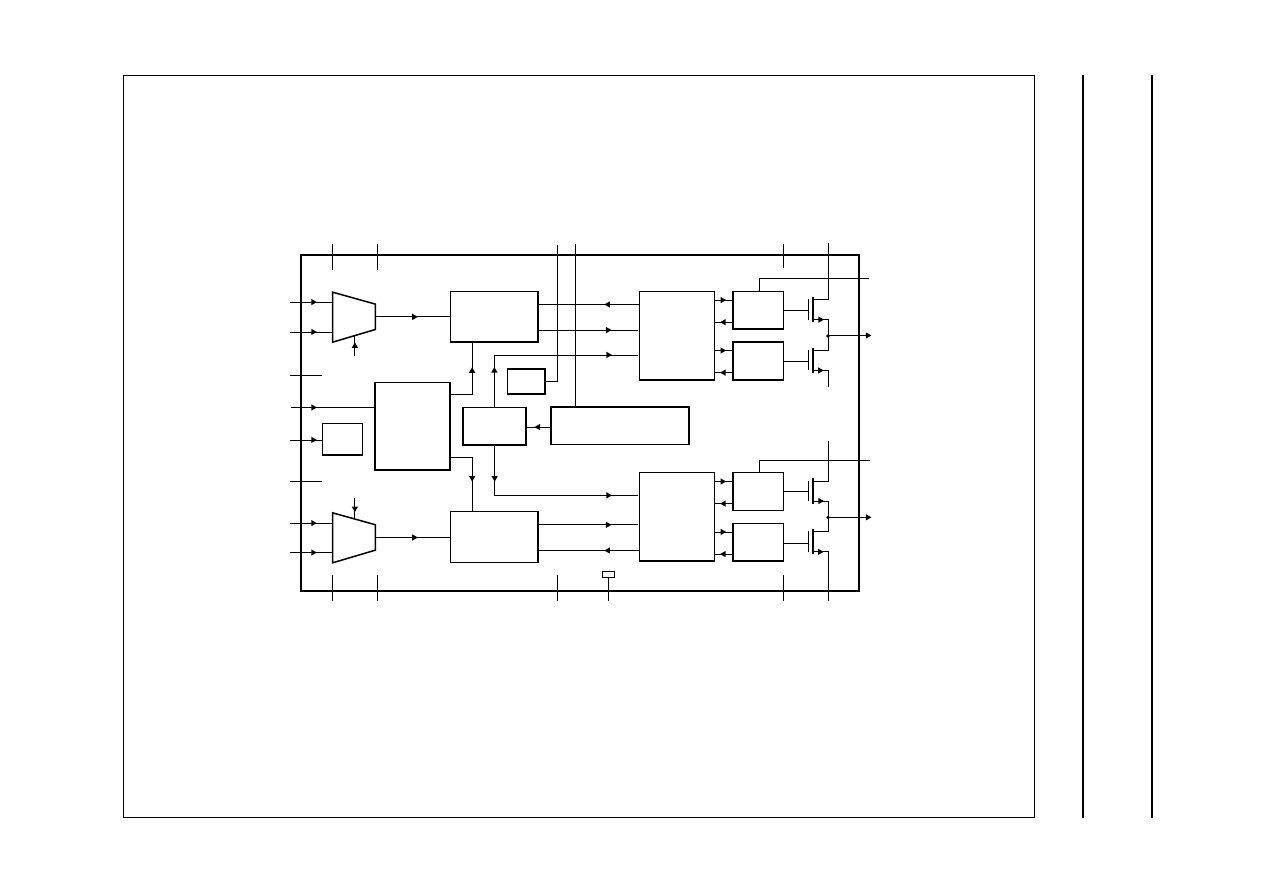
2002
Sep
25
5
Philips Semiconductors
Product specification
2
×
80
W class-D po
w
er amplifier
TD
A8920
This text is here in white to force landscape pages to be rotated correctly when browsing through the pdf in the Acrobat reader.This text is here in
_
white to force landscape pages to be rotated correctly when browsing through the pdf in the Acrobat reader.This text is here inThis text is here in
white to force landscape pages to be rotated correctly when browsing through the pdf in the Acrobat reader. white to force landscape pages to be ...
6
BLOCK DIA
GRAM
handbook, full pagewidth
OUT1
VSSP1
VDDP2
DRIVER
HIGH
MBL461
OUT2
BOOT2
TDA8920TH
BOOT1
DRIVER
LOW
RELEASE1
SWITCH1
ENABLE1
CONTROL
AND
HANDSHAKE
PWM
MODULATOR
MANAGER
OSCILLATOR
TEMPERATURE SENSOR
CURRENT PROTECTION
STABI
MODE
INPUT
STAGE
mute
9
8
IN1
−
IN1
+
22
21
20
17
16
15
VSSP2
VSSP1
DRIVER
HIGH
DRIVER
LOW
RELEASE2
SWITCH2
ENABLE2
CONTROL
AND
HANDSHAKE
PWM
MODULATOR
11
SGND1
7
OSC
2
SGND2
6
MODE
INPUT
STAGE
mute
5
4
IN2
−
IN2
+
19
24
VSSD
HW
1
VSSA2
12
VSSA1
3
VDDA2
10
VDDA1
23
13
18
14
VDDP2
PROT
STABI
VDDP1
Fig.1 Block diagram.
(1) Pin 19 should be connected to pin 24 in the application.
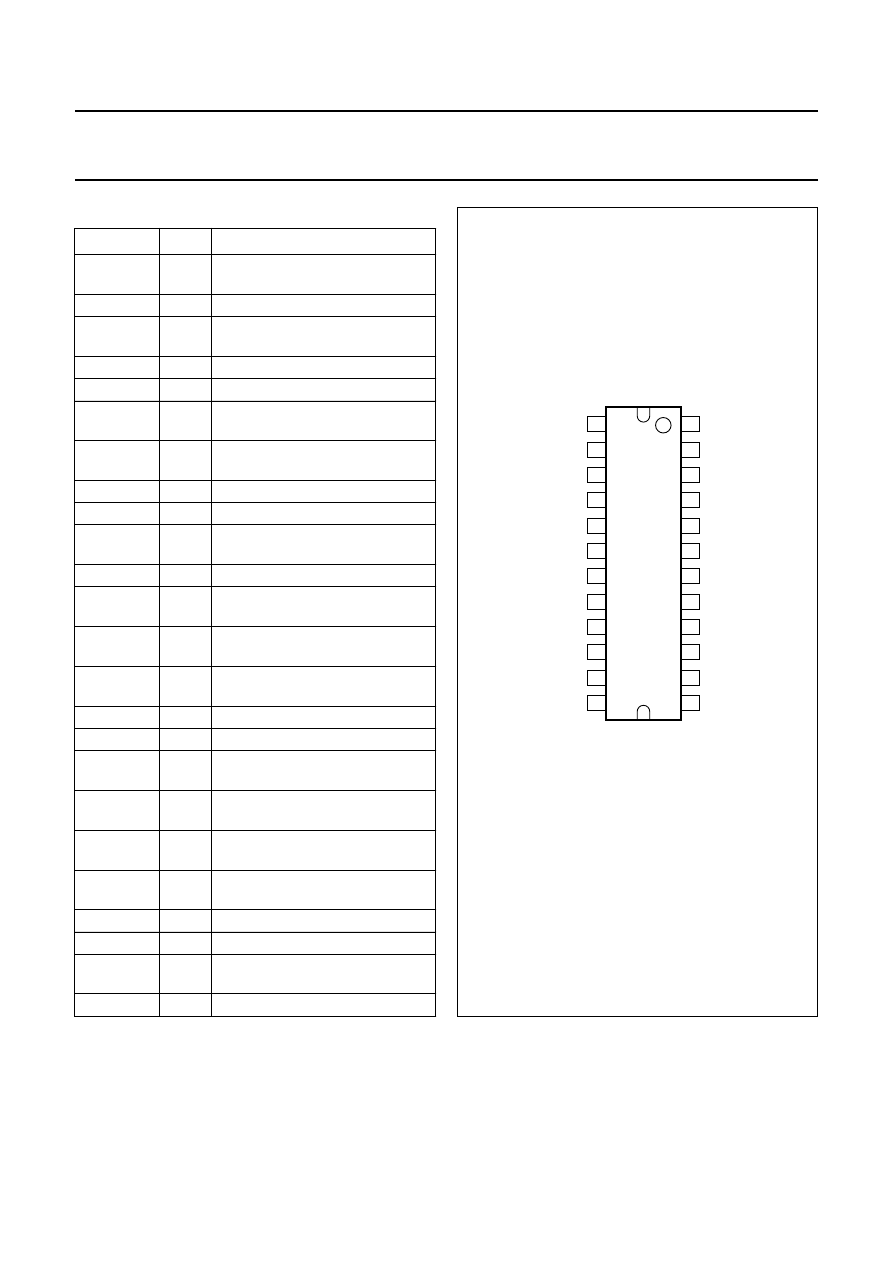
2002 Sep 25
6
Philips Semiconductors
Product specification
2
×
80 W class-D power amplifier
TDA8920
7
PINNING
SYMBOL
PIN
DESCRIPTION
V
SSA2
1
negative analog supply voltage for
channel 2
SGND2
2
signal ground channel 2
V
DDA2
3
positive analog supply voltage for
channel 2
IN2
−
4
negative audio input for channel 2
IN2+
5
positive audio input for channel 2
MODE
6
mode select input
(standby/mute/operating)
OSC
7
oscillator frequency adjustment or
tracking input
IN1+
8
positive audio input for channel 1
IN1
−
9
negative audio input for channel 1
V
DDA1
10
positive analog supply voltage for
channel 1
SGND1
11
signal ground for channel 1
V
SSA1
12
negative analog supply voltage for
channel 1
PROT
13
time constant capacitor for
protection delay
V
DDP1
14
positive power supply for
channel 1
BOOT1
15
bootstrap capacitor for channel 1
OUT1
16
PWM output from channel 1
V
SSP1
17
negative power supply voltage for
channel 1
STABI
18
decoupling internal stabilizer for
logic supply
HW
19
handle wafer; must be connected
to pin 24
V
SSP2
20
negative power supply voltage for
channel 2
OUT2
21
PWM output from channel 2
BOOT2
22
bootstrap capacitor for channel 2
V
DDP2
23
positive power supply voltage for
channel 2
V
SSD
24
negative digital supply voltage
handbook, halfpage
MBL462
HW
PROT
BOOT1
VDDP1
VSSP1
OUT1
BOOT2
VSSP2
OUT2
VSSD
VDDP2
STABI
MODE
VSSA1
VDDA1
SGND1
IN1
+
IN1
−
VDDA2
IN2
+
IN2
−
VSSA2
SGND2
OSC
TDA8920TH
1
2
3
4
5
6
7
8
9
10
11
12
24
23
22
21
20
19
18
17
16
15
14
13
Fig.2 Pin configuration.
(1) Pin 19 should be connected to pin 24 in the application.
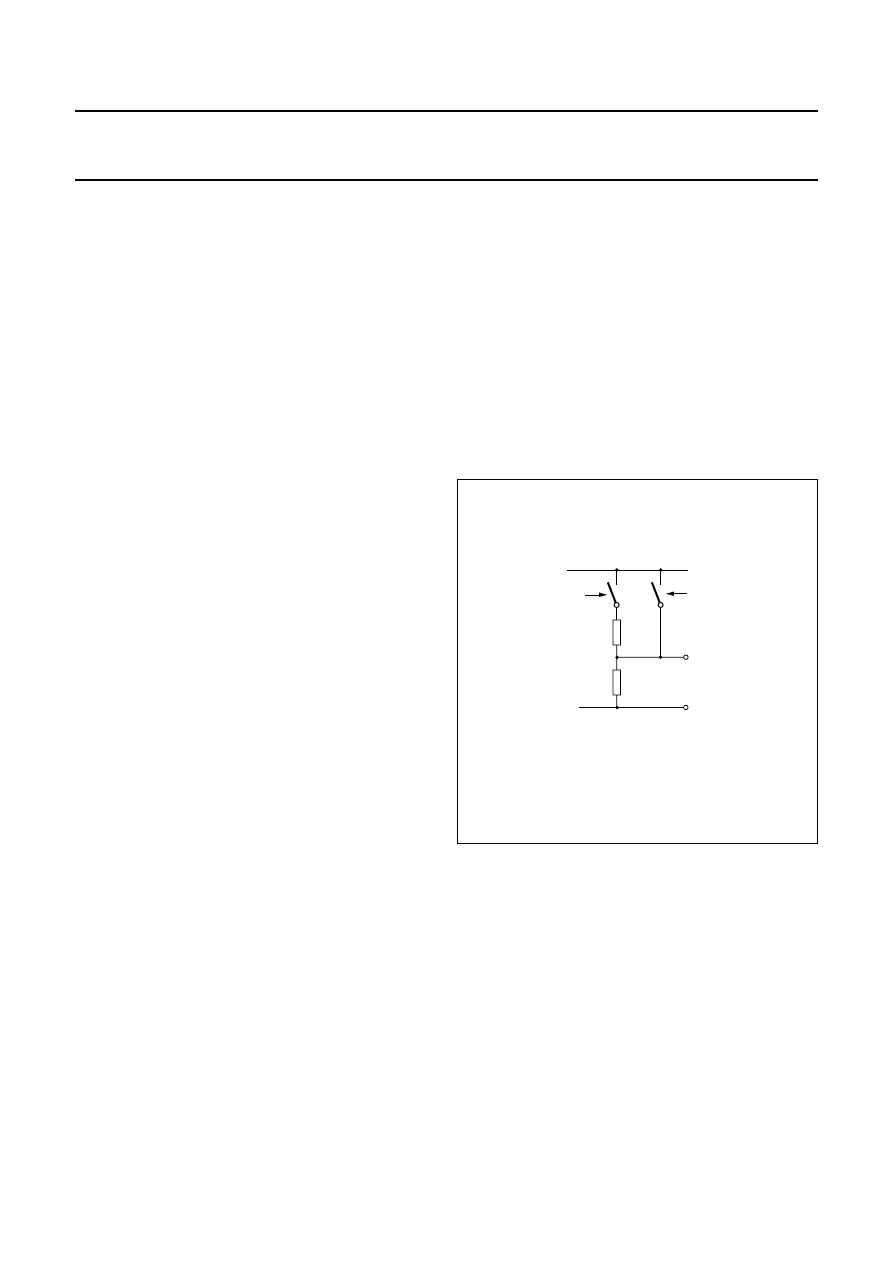
2002 Sep 25
7
Philips Semiconductors
Product specification
2
×
80 W class-D power amplifier
TDA8920
8
FUNCTIONAL DESCRIPTION
8.1
General
The TDA8920 is a two channel audio power amplifier using
class-D technology. A typical application diagram is
illustrated in Fig.37. A detailed application reference
design is given in Section 16.8. The audio input signal is
converted into a digital Pulse Width Modulated (PWM)
signal via an analog input stage and PWM modulator.
To enable the output power transistors to be driven, this
digital PWM signal is applied to a control and handshake
block and driver circuits for both the high side and low side.
In this way a level shift is performed from the low power
digital PWM signal (at logic levels) to a high power PWM
signal which switches between the main supply lines.
A 2nd-order low-pass filter converts the PWM signal to an
analog audio signal across the loudspeaker.
The TDA8920TH one-chip class-D amplifier contains high
power D-MOS switches, drivers, timing and handshaking
between the power switches and some control logic. For
protection a temperature sensor and a maximum current
detector are built-in.
The two audio channels of the TDA8920TH contain two
PWMs, two analog feedback loops and two differential
input stages. It also contains circuits common to both
channels such as the oscillator, all reference sources, the
mode functionality and a digital timing manager.
The TDA8920TH contains two independent amplifier
channels with high output power, high efficiency (90%),
low distortion and a low quiescent current. The amplifier
channels can be connected in the following configurations:
•
Mono Bridge-Tied Load (BTL) amplifier
•
Stereo Single-Ended (SE) amplifiers.
The amplifier system can be switched in three operating
modes with the MODE select pin:
•
Standby mode; with a very low supply current
•
Mute mode; the amplifiers are operational, but the audio
signal at the output is suppressed
•
Operating mode (amplifier fully operational) with output
signal.
For suppressing plop noise the amplifier will remain,
automatically, in the mute mode for approximately 150 ms
before switching to operating mode; see Fig.4. In this time
the coupling capacitors at the input are fully charged.
An example of a switching circuit for driving the mode pin
is illustrated in Fig.3.
handbook, halfpage
standby/
mute
R
R
mute/on
MODE pin
SGND
MBL463
+
5 V
Fig.3 Example of mode select circuit.
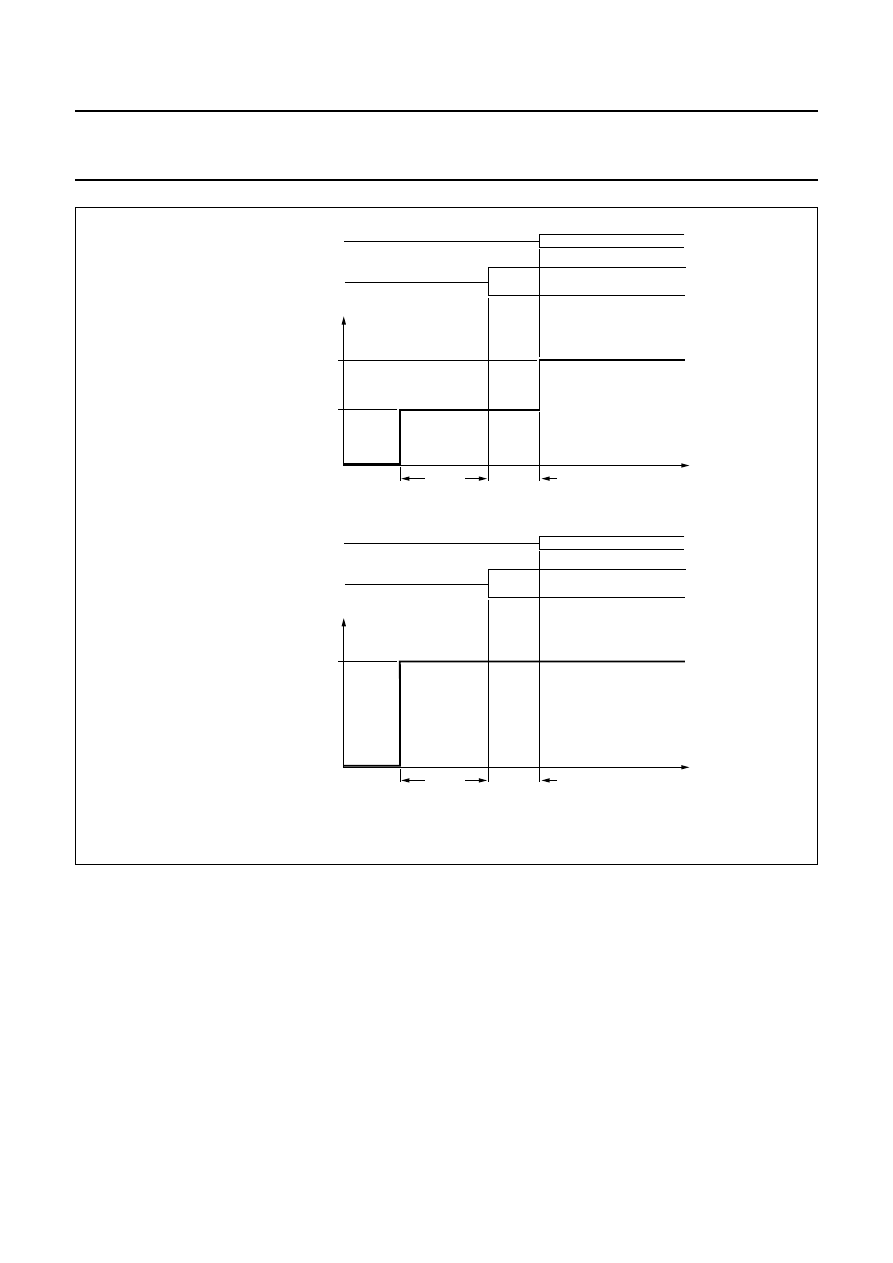
2002 Sep 25
8
Philips Semiconductors
Product specification
2
×
80 W class-D power amplifier
TDA8920
handbook, full pagewidth
audio
operating
mute
standby
4 V
2 V
0 V (SGND)
time
Vmode
100 ms
>50 ms
switching
audio
operating
standby
4 V
0 V (SGND)
time
MBL465
Vmode
100 ms
50 ms
switching
Fig.4 Timing on mode select input.
When switching from standby
to operating there is a first
delay of 100 ms before the
outputs starts switching. The
audio signal is available after
a second delay of 50 ms.
When switching from standby
to mute there is a delay of
100 ms before the output
starts switching. The audio
signal is available after the
mode pin has been set to
operating, but not earlier than
150 ms after switching to
mute.
8.2
Pulse width modulation frequency
The output signal of the amplifier is a PWM signal with a
carrier frequency of approximately 350 kHz. Using a
2nd-order LC demodulation filter in the application results
in an analog audio signal across the loudspeaker. This
switching frequency is fixed by an external resistor R
OSC
connected between pin OSC and V
SSA
. With the resistor
value given in the schematic diagram of the reference
design, the carrier frequency is typical 350 kHz. The
carrier frequency can be calculated using the following
equation:
If two or more class-D amplifiers are used in the same
audio application, it is advisable to have all devices
operating at the same switching frequency.
This can be realized by connecting all OSC pins together
and feed them from a external central oscillator. Using an
external oscillator it is necessary to force the OSC pin to a
DC-level above SGND for switching from internal to
external oscillator. In this case the internal oscillator is
disabled and the PWM will be switched on the external
frequency. The frequency range of the external oscillator
must be in the range as specified in the switching
characteristics; see Chapter 13.
f
OSC
9
10
9
×
R
OSC
------------------- Hz
=

2002 Sep 25
9
Philips Semiconductors
Product specification
2
×
80 W class-D power amplifier
TDA8920
Application in a practical circuit:
Internal oscillator: R
osc
connected from pin OSC to V
SS
External oscillator: connect oscillator signal between pin
OSC and SGND; delete R
OSC
and C
OSC
.
8.3
Protections
Temperature, supply voltage and short-circuit protections
sensors are included on the chip. In the event that the
maximum current or maximum temperature is exceeded
the system will shut down.
8.3.1
O
VER
-
TEMPERATURE
If the junction temperature (T
j
) exceeds 150
°
C, then the
power stage will shut down immediately. The power stage
will start switching again if the temperature drops to
approximately 130
°
C, thus there is a hysteresis of
approximately 20
°
C.
8.3.2
S
HORT
-
CIRCUIT ACROSS THE LOUDSPEAKER
TERMINALS AND TO SUPPLY LINES
When the loudspeaker terminals are short-circuited or if
one of the demodulated outputs of the amplifier is
short-circuited to one of the supply lines this will be
detected by the current protection. If the output current
exceeds the maximum output current of 7.5 A, then the
power stage will shut down within less than 1
µ
s and the
high current will be switched off. In this state the
dissipation is very low. Every 100 ms the system tries to
restart again. If there is still a short-circuit across the
loudspeaker load or to one of the supply lines, the system
is switched off again as soon as the maximum current is
exceeded. The average dissipation will be low because of
this low duty cycle.
8.3.3
S
TART
-
UP SAFETY TEST
During the start-up sequence, when the mode pin is
switched from standby to mute, the condition at the output
terminals of the power stage are checked. In the event of
a short-circuit at one of the output terminals to V
DD
or V
SS
the start-up procedure is interrupted and the systems waits
for open-circuit outputs. Because the test is done before
enabling the power stages, no large currents will flow in the
event of a short-circuit. This system protects for
short-circuits at both sides of the output filter to both supply
lines. When there is a short-circuit from the power PWM
output of the power stage to one of the supply lines (before
the demodulation filter) it will also be detected by the
‘start-up safety test’. Practical use of this test feature can
be found in detection of short-circuits on the printed-circuit
board.
Remark: this test is only operational prior to or during the
start-up sequence, and not during normal operation.
During normal operation the maximum current protection
is used to detect short-circuits across the load and with
respect to the supply lines.
8.3.4
S
UPPLY VOLTAGE ALARM
If the supply voltage falls below
±
12.5 V the undervoltage
protection is activated and system shuts down correctly. If
the internal clock is used this switch-off will be silent and
without plop noise. When the supply voltage rises above
the threshold level the system is restarted again after
100 ms. If the supply voltage exceeds
±
32 V the
overvoltage protection is activated and the power stages
shut down. They are re-enabled as soon as the supply
voltage drops below the threshold level.
An additional balance protection circuit compares the
positive (V
DD
) and the negative (V
SS
) supply voltages and
is triggered if the voltage difference between them
exceeds a certain level. This level depends on the sum of
both supply voltages. An expression for the unbalanced
threshold level is as follows: V
unb,thr
~ 0.15
×
(V
DD
+ V
SS
).
Example: with a symmetrical supply of
±
30 V the
protection circuit will be triggered if the unbalance exceeds
approximately 9 V; see also Section 16.7.
8.4
Differential audio inputs
For a high common mode rejection ratio and a maximum
of flexibility in the application, the audio inputs are fully
differential. By connecting the inputs anti-parallel the
phase of one of the channels can be inverted, so that a
load can be connected between the two output filters.
In this case the system operates as a mono BTL amplifier
and with the same loudspeaker impedance an
approximately four times higher output power can be
obtained. The input configuration for mono BTL application
is illustrated in Fig.5; for more information see Chapter 16.
In the stereo single-ended configuration it is also
recommended to connect the two differential inputs in
anti-phase. This has advantages for the current handling
of the power supply at low signal frequencies.
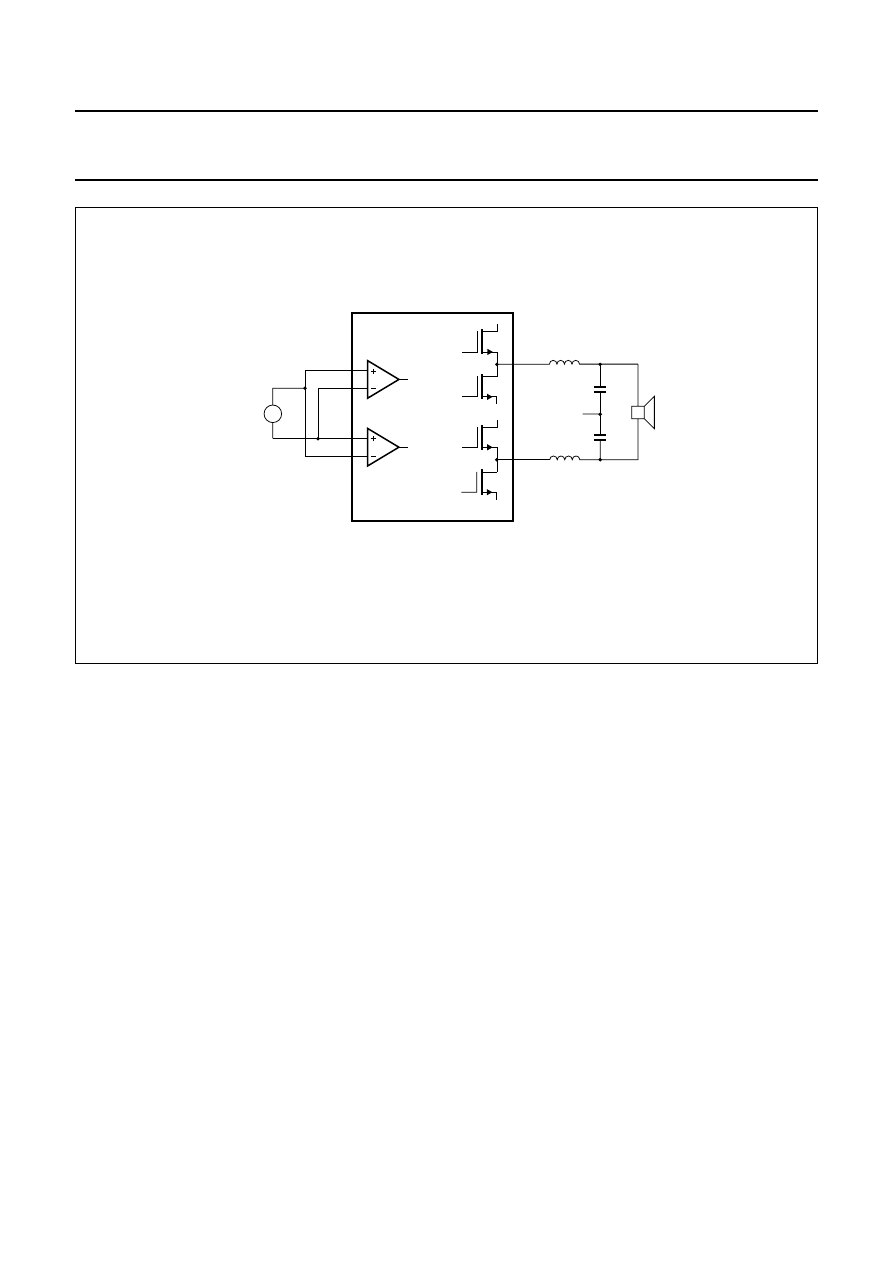
2002 Sep 25
10
Philips Semiconductors
Product specification
2
×
80 W class-D power amplifier
TDA8920
handbook, full pagewidth
Vin
IN1
+
OUT1
power stage
MBL466
OUT2
SGND
IN1
−
IN2
+
IN2
−
Fig.5 Input configuration for mono BTL application.

2002 Sep 25
11
Philips Semiconductors
Product specification
2
×
80 W class-D power amplifier
TDA8920
9
LIMITING VALUES
In accordance with the Absolute Maximum Rating System (IEC 60134).
Notes
1. See also Section 16.6.
2. Human Body Model (HBM); R
s
= 1500
Ω
; C = 100 pF.
3. Machine Model (MM); R
s
= 10
Ω
; C = 200 pF; L = 0.75 mH.
10 THERMAL CHARACTERISTICS
Note
1. See also Section 16.5.
SYMBOL
PARAMETER
CONDITIONS
MIN.
MAX.
UNIT
V
P
supply voltage
−
±
30
V
V
ms
mode select switch input voltage
with respect to SGND
−
5.5
V
V
sc
short-circuit voltage of output pins
−
±
30
V
I
ORM
repetitive peak current in output pin
note 1
−
7.5
A
T
stg
storage temperature
−
55
+150
°
C
T
amb
ambient temperature
−
40
+85
°
C
T
vj
virtual junction temperature
−
150
°
C
V
es(HBM)
electrostatic discharge voltage (HBM) note 2
all pins with respect to V
DD
(class 1a)
−
1500 +1500 V
all pins with respect to SGND (class 1a)
−
1500 +1500 V
all pins with respect to V
SS
(class 1a)
−
1500 +1500 V
all pins (except pin 19) with respect to
each other (class 1a)
−
1500 +1500 V
pin 19 (HW) with respect to all other pins
−
500
+500
V
V
es(MM)
electrostatic discharge voltage (MM)
note 3
all pins with respect to V
DD
(class B)
−
250
+250
V
all pins with respect to SGND (class B)
−
250
+250
V
all pins with respect to V
SS
(class A1)
−
150
+150
V
all pins with respect to each other
(class A1)
−
100
+100
V
SYMBOL
PARAMETER
CONDITIONS
VALUE
UNIT
R
th(j-a)
thermal resistance from junction to ambient
in free air; note 1
35
K/W
R
th(j-c)
thermal resistance from junction to case
note 1
1.3
K/W
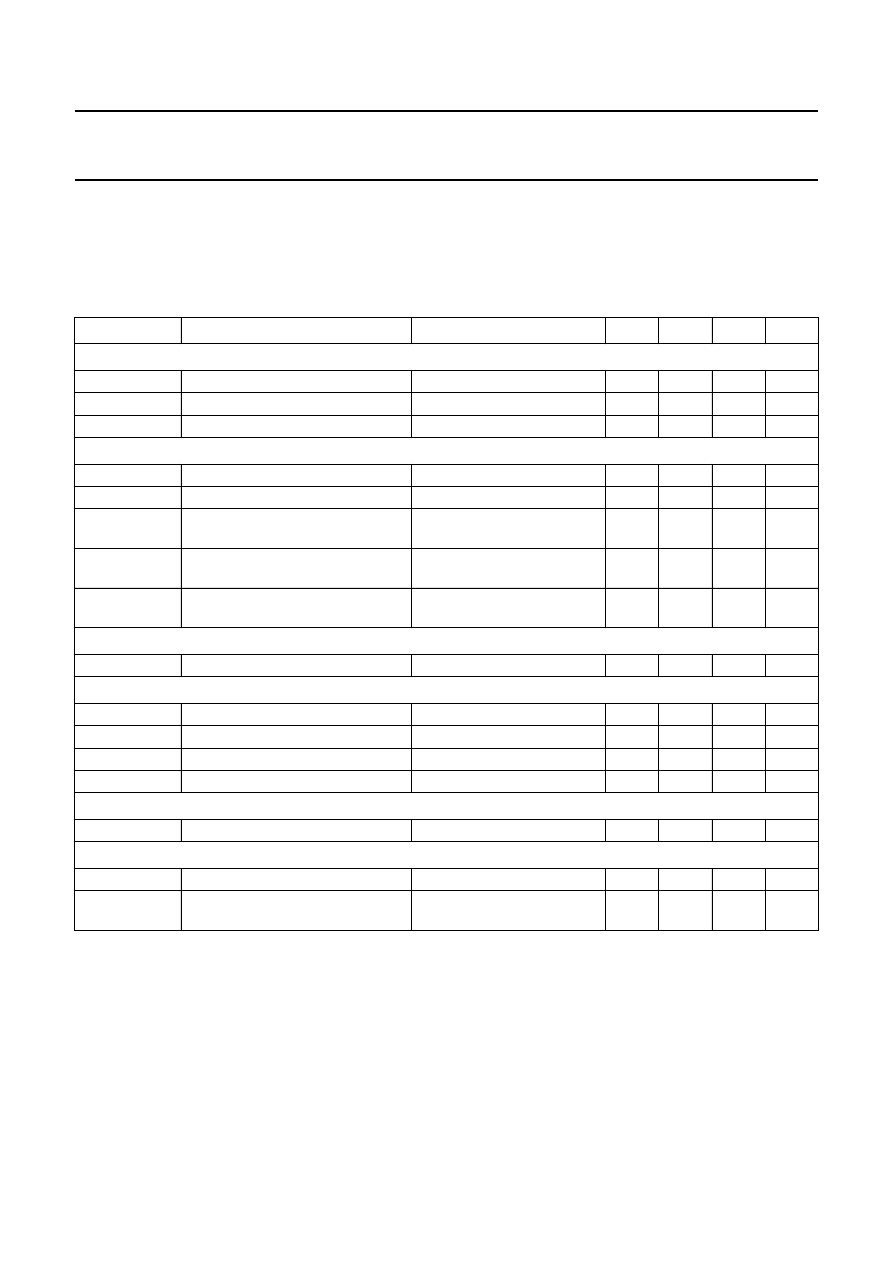
2002 Sep 25
12
Philips Semiconductors
Product specification
2
×
80 W class-D power amplifier
TDA8920
11 QUALITY SPECIFICATION
In accordance with
“SNW-FQ611-part D” if this type is used as an audio amplifier (except for ESD; see also Chapter 9).
12 STATIC CHARACTERISTICS
V
P
=
±
25 V; T
amb
= 25
°
C; measured in Fig.9; unless otherwise specified.
Notes
1. The circuit is DC adjusted at V
P
=
±
12.5 to
±
30 V.
2. With respect to SGND (0 V).
3. The transition regions between standby, mute and on contain hysteresis (see Fig.6).
4. With respect to V
SS1
.
SYMBOL
PARAMETER
CONDITIONS
MIN.
TYP.
MAX.
UNIT
Supply
V
P
supply voltage range
note 1
±
12.5
±
25
±
30
V
I
q
quiescent current
no load connected
−
55
75
mA
I
stb
standby current
−
100
500
µ
A
Mode select input; pin MODE
V
ms
input voltage
note 2
0
−
5.5
V
I
ms
input current
V
ms
= 5.5 V
−
−
1000
µ
A
V
stb
input voltage in mode select for
standby mode
notes 2 and 3
0
−
0.8
V
V
mute
input voltage in mode select for
mute mode
notes 2 and 3
2.2
−
3.0
V
V
on
input voltage in mode select for on
mode
notes 2 and 3
4.2
−
5.5
V
Audio inputs; pins IN2
−
, IN2+, IN1+ and IN1
−
V
I
DC input voltage
note 2
−
0
−
V
Amplifier outputs; pins OUT1 and OUT2
V
OOSE
output offset voltage
SE; on and mute
−
−
150
mV
∆
V
OOSE
variation of output offset voltage
SE; on
↔
mute
−
−
80
mV
V
OOBTL
output offset voltage
BTL; on and mute
−
−
215
mV
∆
V
OOBTL
variation of output offset voltage
BTL; on
↔
mute
−
−
115
mV
Stabilizer; pin STABI
V
o(stab)
stabilizer output voltage
mute and operating; note 4
11
13
15
V
Temperature protection
T
prot
temperature protection activation
150
−
−
°
C
T
hys
hysteresis on temperature
protection
−
20
−
°
C
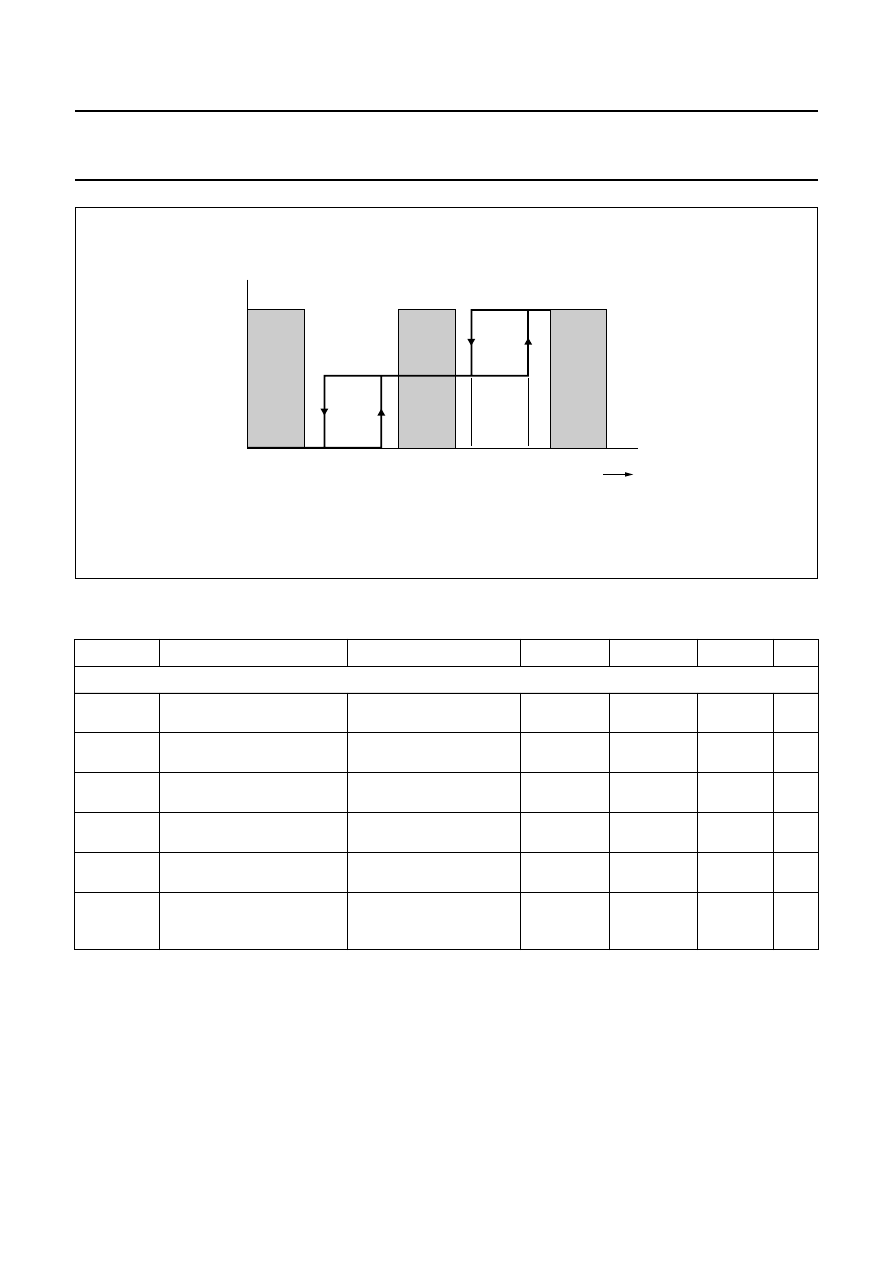
2002 Sep 25
13
Philips Semiconductors
Product specification
2
×
80 W class-D power amplifier
TDA8920
handbook, full pagewidth
STBY
MUTE
ON
5.5
MBL467
VMODE (V)
4.2
3.0
2.2
0.8
0
Fig.6 Mode select pin behaviour.
13 SWITCHING CHARACTERISTICS
V
DD
=
±
25 V; T
amb
= 25
°
C; measured in Fig.9; unless otherwise specified.
Note
1. Frequency set with R
OSC
, according to formula in Chapter 8.
SYMBOL
PARAMETER
CONDITIONS
MIN.
TYP.
MAX.
UNIT
Switching frequency
f
osc
typical internal oscillator
frequency
R
OSC
= 30.0 k
Ω
;
see Section 16.11
290
317
344
kHz
f
osc(int)
internal oscillator frequency
range
note 1
210
−
600
kHz
V
OSC
voltage at OSC pin
external oscillator or
frequency tracking
SGND + 4.5 SGND + 5
SGND + 6 V
V
OSC(trip)
trip level at OSC pin for
tracking
external oscillator or
frequency tracking
−
SGND + 2.5
−
V
f
track
frequency range for tracking external oscillator or
frequency tracking
210
−
600
kHz
V
P(OSC)(ext)
minimum symmetrical
supply voltage for external
oscillator application
external oscillator
15
−
−
V
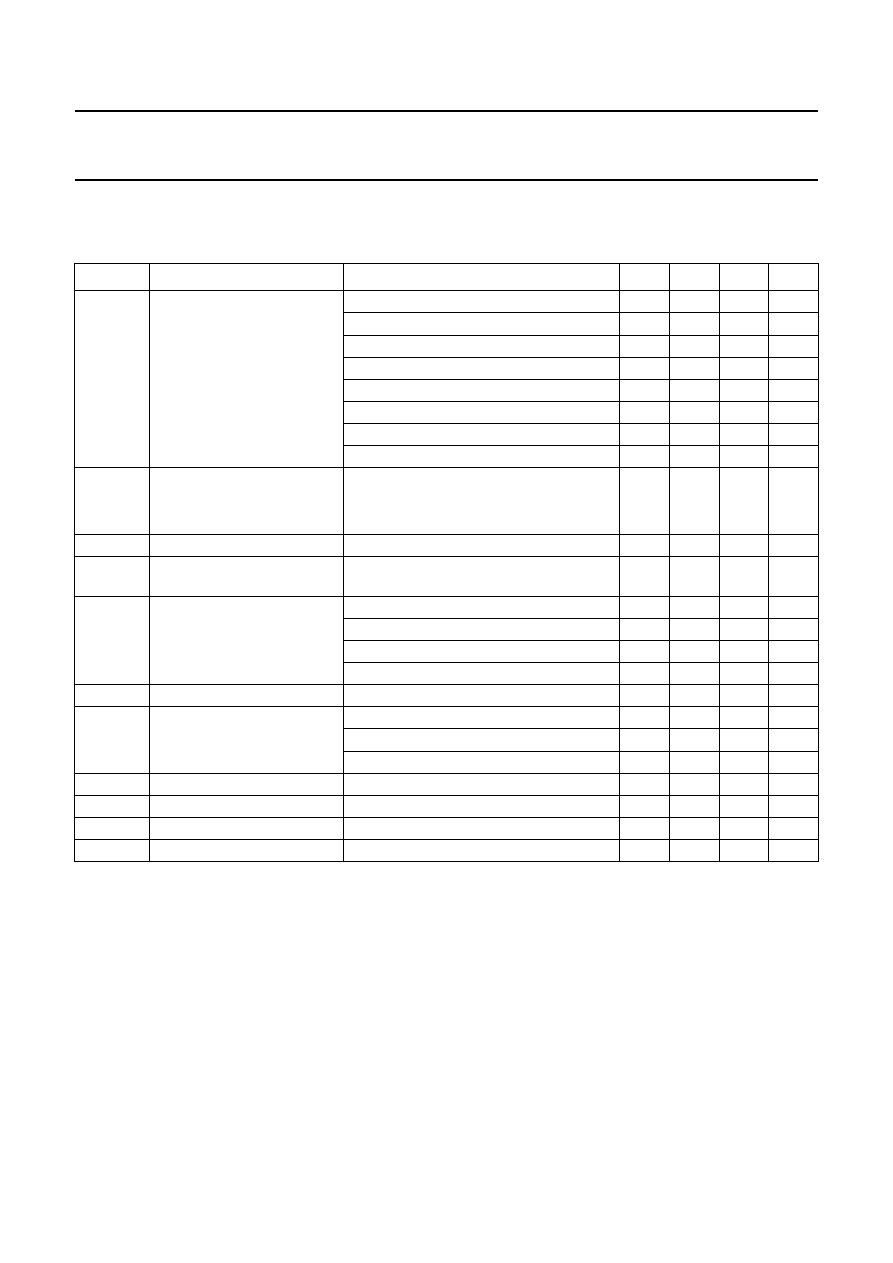
2002 Sep 25
14
Philips Semiconductors
Product specification
2
×
80 W class-D power amplifier
TDA8920
14 DYNAMIC AC CHARACTERISTICS (STEREO AND DUAL SE APPLICATION)
V
P
=
±
25 V; R
L
= 4
Ω
; f
i
= 1 kHz; f
osc
= 310 kHz; R
sL
< 0.1
Ω
(note 1); T
amb
= 25
°
C; measured in Fig.9; unless
otherwise specified.
Notes
1. R
sL
= series resistance of inductor of low-pass LC filter in the application.
2. Output power is measured indirectly; based on R
DSon
measurement.
3. Total harmonic distortion is measured in a bandwidth of 22 Hz to 22 kHz. When distortion is measured using a lower
order low-pass filter a significantly higher value is found, due to the switching frequency outside the audio band.
Maximum limit is guaranteed but may not be 100% tested.
4. Output power measured across the loudspeaker load.
5. V
ripple
= V
ripple(max)
= 2 V (p-p); f
i
= 100 Hz; R
s
= 0
Ω
.
6. V
ripple
= V
ripple(max)
= 2 V (p-p); f
i
= 1 kHz; R
s
= 0
Ω
.
7. B = 22 Hz to 22 kHz; R
s
= 0
Ω
; maximum limit is guaranteed but may not be 100% tested.
8. B = 22 Hz to 22 kHz; R
s
= 10 k
Ω
.
9. B = 22 Hz to 22 kHz; independent of R
s
.
SYMBOL
PARAMETER
CONDITIONS
MIN.
TYP.
MAX.
UNIT
P
o
output power
R
L
= 8
Ω
; V
P
=
±
20 V; THD = 0.5%; note 2 18
20
−
W
R
L
= 8
Ω
; V
P
=
±
20 V; THD = 10%; note 2
23
25
−
W
R
L
= 8
Ω
; V
P
=
±
25 V; THD = 0.5%; note 2 28
30
−
W
R
L
= 8
Ω
; V
P
=
±
25 V; THD = 10%; note 2
36
39
−
W
R
L
= 4
Ω
; V
P
=
±
25 V; THD = 0.5%; note 2 51
55
−
W
R
L
= 4
Ω
; V
P
=
±
25 V; THD = 10%; note 2
65
70
−
W
R
L
= 4
Ω
; V
P
=
±
27 V; THD = 0.5%; note 2 60
65
−
W
R
L
= 4
Ω
; V
P
=
±
27 V; THD = 10%; note 2
74
80
−
W
THD
total harmonic distortion
P
o
= 1 W; note 3
f
i
= 1 kHz
−
0.02
0.05
%
f
i
= 10 kHz
−
0.15
−
%
G
v(cl)
closed-loop voltage gain
29
30
31
dB
η
efficiency
P
o
= 30 W; SE: R
L
= 2
×
8
Ω
; f
i
= 1 kHz;
note 4
85
90
−
%
SVRR
supply voltage ripple
rejection
on; f
i
= 100 Hz; note 5
−
55
−
dB
on; f
i
= 1 kHz; note 6
40
50
−
dB
mute; f
i
= 100 Hz; note 5
−
55
−
dB
standby; f
i
= 100 Hz; note 5
−
80
−
dB
Z
i
input impedance
45
68
−
k
Ω
V
n(o)
noise output voltage
on; R
s
= 0
Ω
; note 7
−
200
400
µ
V
on; R
s
= 10 k
Ω
; note 8
−
230
−
µ
V
mute; note 9
−
220
−
µ
V
α
cs
channel separation
note 10
−
70
−
dB
∆
G
v
channel unbalance
−
−
1
dB
V
o(mute)
output signal in mute
note 11
−
−
400
µ
V
CMRR
common mode rejection ratio V
i(CM)
= 1 V (RMS)
−
75
−
dB

2002 Sep 25
15
Philips Semiconductors
Product specification
2
×
80 W class-D power amplifier
TDA8920
10. P
o
= 1 W; R
s
= 0
Ω
; f
ι
= 1 kHz.
11. V
i
= V
i(max)
= 1 V (RMS); maximum limit is guaranteed but may not be 100% tested.
15 DYNAMIC AC CHARACTERISTICS (MONO BTL APPLICATION)
V
P
=
±
25 V; R
L
= 8
Ω
; f
i
= 1 kHz; f
osc
= 310 kHz; R
sL
< 0.1
Ω
(note 1); T
amb
= 25
°
C; measured in Fig.9; unless
otherwise specified.
Notes
1. R
sL
= series resistance of inductor of low-pass LC filter in the application.
2. Output power is measured indirectly; based on R
DSon
measurement.
3. Total harmonic distortion is measured in a bandwidth of 22 Hz to 22 kHz. When distortion is measured using a low
order low-pass filter a significant higher value will be found, due to the switching frequency outside the audio band.
Maximum limit is guaranteed but may not be 100% tested.
4. Output power measured across the loudspeaker load.
5. V
ripple
= V
ripple(max)
= 2 V (p-p); f
i
= 100 Hz; R
s
= 0
Ω
.
6. V
ripple
= V
ripple(max)
= 2 V (p-p); f
i
= 1 kHz; R
s
= 0
Ω
.
7. B = 22 Hz to 22 kHz; R
s
= 0
Ω
; maximum limit is guaranteed but may not be 100% tested.
8. B = 22 Hz to 22 kHz; R
s
= 10 k
Ω
.
9. B = 22 Hz to 22 kHz; independent of R
s
.
10. V
i
= V
i(max)
= 1 V (RMS); f
i
= 1 kHz; maximum limit is guaranteed but may not be 100% tested.
SYMBOL
PARAMETER
CONDITIONS
MIN.
TYP.
MAX.
UNIT
P
o
output power
R
L
= 8
Ω
; V
P
=
±
25 V; THD = 0.5%; note 2 100
110
−
W
R
L
= 8
Ω
; V
P
=
±
25 V; THD = 10%; note 2
128
140
−
W
R
L
= 8
Ω
; V
P
=
±
21 V; THD = 0.5%; note 2 73
79
−
W
R
L
= 8
Ω
; V
P
=
±
21 V; THD = 10%; note 2
92
100
−
W
R
L
= 4
Ω
; V
P
=
±
17 V; THD = 0.5%; note 2 66
75
−
W
R
L
= 4
Ω
; V
P
=
±
17 V; THD = 10%; note 2
100
110
−
W
THD
total harmonic distortion
P
o
= 1 W; note 3
f
i
= 1 kHz
−
0.015
0.05
%
f
i
= 10 kHz
−
0.02
−
%
G
v(cl)
closed-loop voltage gain
35
36
37
dB
η
efficiency
P
o
= 140 W; f
i
= 1 kHz; note 4
85
89
−
%
SVRR
supply voltage ripple
rejection
on; f
i
= 100 Hz; note 5
−
49
−
dB
on; f
i
= 1 kHz; note 6
36
44
−
dB
mute; f
i
= 100 Hz; note 5
−
49
−
dB
standby; f
i
= 100 Hz; note 5
−
80
−
dB
Z
i
input impedance
22
34
−
k
Ω
V
n(o)
noise output voltage
on; R
s
= 0
Ω
; note 7
−
280
560
µ
V
on; R
s
= 10 k
Ω
; note 8
−
300
−
µ
V
mute; note 9
−
280
−
µ
V
V
o(mute)
output signal in mute
note 10
−
−
500
µ
V
CMRR
common mode rejection ratio V
i(CM)
= 1 V (RMS)
−
75
−
dB
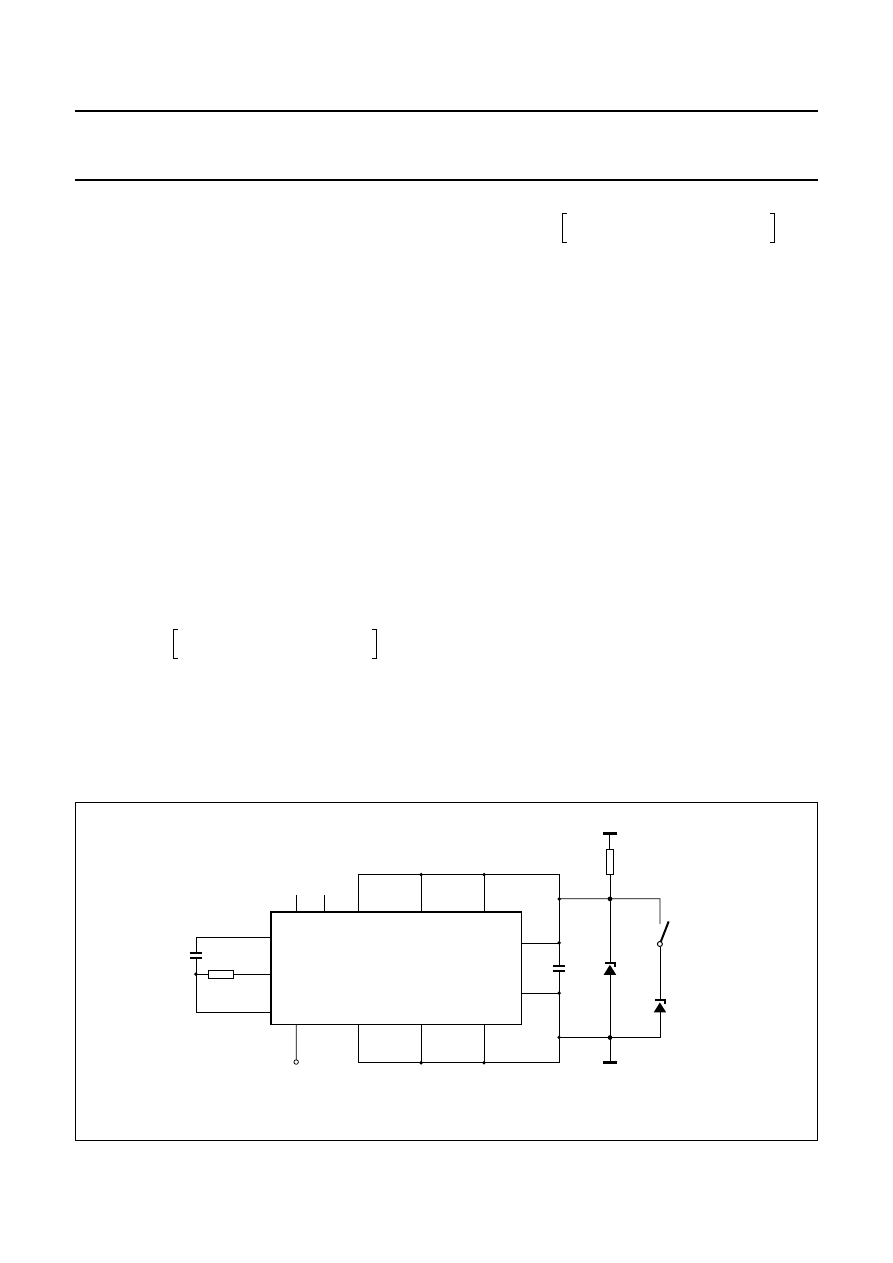
2002 Sep 25
16
Philips Semiconductors
Product specification
2
×
80 W class-D power amplifier
TDA8920
16 APPLICATION INFORMATION
16.1
BTL application
When using the system in the mono BTL application (for
more output power), the inputs of both channels must be
connected in parallel; the phase of one of the inputs must
be inverted; see Fig.5. In principle the loudspeaker can be
connected between the outputs of the two single-ended
demodulation filters.
16.2
MODE pin
For correct operation the switching voltage at the mode pin
should be debounced. If the mode pin is driven by a
mechanical switch an appropriate debouncing low-pass
filter should be used. If the mode pin is driven by an
electronic circuit or microcontroller then it should remain at
the mute voltage level for at least 100 ms before switching
back to the standby voltage level.
16.3
Output power estimation
The output power in several applications (SE and BTL)
can be estimated using the following expressions:
SE:
Maximum current:
should not exceed 7.5 A.
BTL:
Maximum current:
should not exceed 7.5 A.
Legend:
R
L
= load impedance
f
osc
= oscillator frequency
t
min
= minimum pulse width (typical 190 ns)
V
P
= single-sided supply voltage (so if supply
±
30 V
symmetrical
→
V
P
= 30 V)
P
out_1%
= output power just at clipping
P
out_10%
= output power at THD = 10%
P
out_10%
= 1.25
×
P
out_1%
.
16.4
External clock
The minimum required symmetrical supply voltage for
external clock application is
±
15 V (equally the minimum
asymmetrical supply for applications with an external clock
is 30 V).
When using an external clock the following accuracy of the
duty cycle of the external clock has to be taken into
account; 47.5% < DC, external clock < 52.5%.
A possible solution for an external clock oscillator circuit is
illustrated in Fig.7.
P
out_1%
R
L
R
L
0.6
+
---------------------
V
P
1
t
min
f
osc
×
–
(
)
×
×
2
2
R
L
×
------------------------------------------------------------------------------------------
=
I
out^
V
P
1
t
min
f
osc
×
–
(
)
×
R
L
0.6
+
-----------------------------------------------------
=
P
out_1%
R
L
R
L
1.2
+
---------------------
2V
P
1
t
min
f
osc
×
–
(
)
×
×
2
2
R
L
×
---------------------------------------------------------------------------------------------
=
I
out^
2V
P
1
t
min
f
osc
×
–
(
)
×
R
L
1.2
+
---------------------------------------------------------
=
handbook, full pagewidth
1
14
7
2
11
13
10
4
5
6
8
9
12
3
CTC
0
−
0
+
ASTAB
−
ASTAB
+
−
TRIGGER
+
TRIGGER
RETRIGGER
MR
220
nF
5.6 V
4.3 V
HOP
GND
MBL468
HEF4047BT
VDD
360 kHz
320 kHz
VDDA
VSS
9.1 k
Ω
2 k
Ω
120 pF
RTC
CLOCK
RCTC
Fig.7 External oscillator circuit.
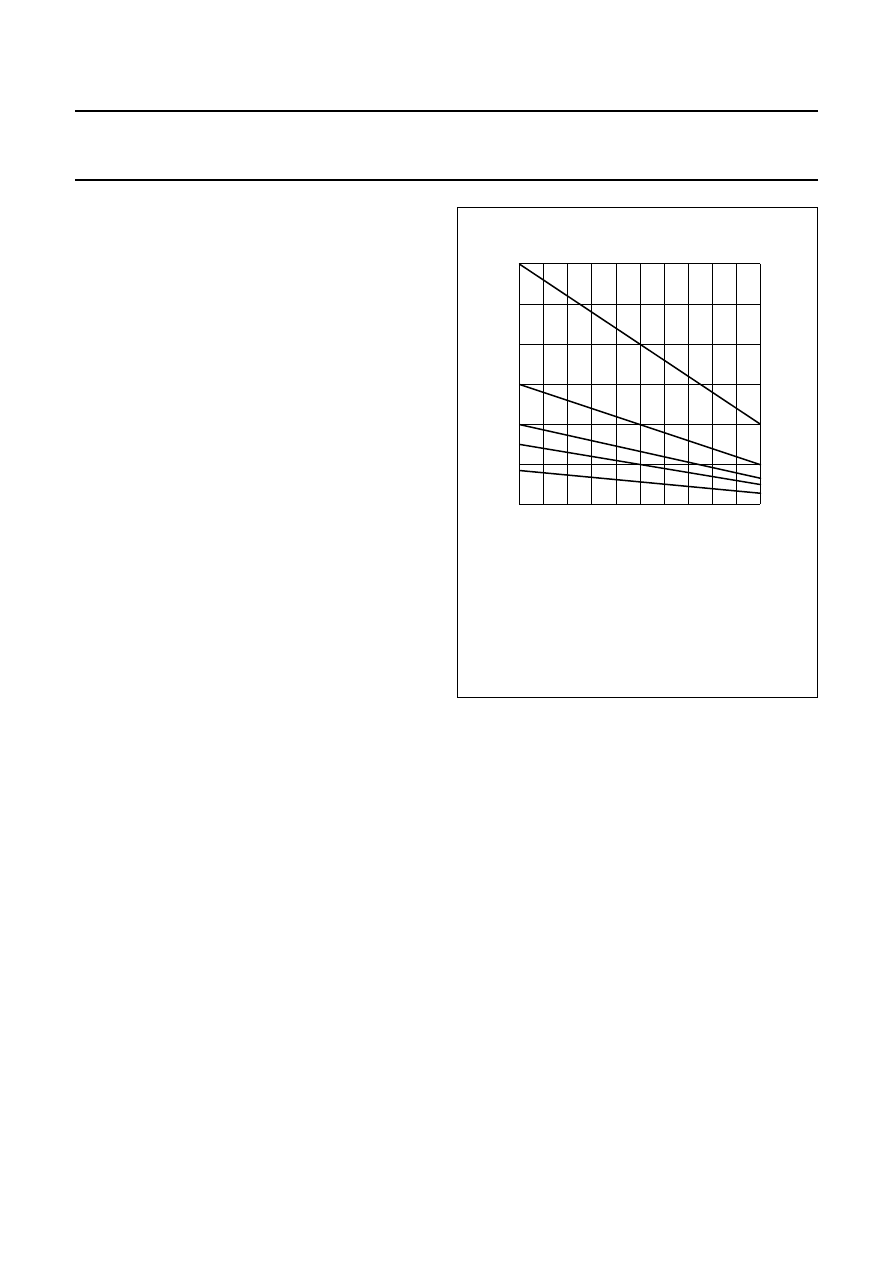
2002 Sep 25
17
Philips Semiconductors
Product specification
2
×
80 W class-D power amplifier
TDA8920
16.5
Heatsink requirements
In some applications it may be necessary to connect an
external heatsink to the TDA8920TH. The determining
factor is the 150
°
C maximum junction temperature
[T
j(max)
] which cannot be exceeded. The expression below
shows the relationship between the maximum allowable
power dissipation and the total thermal resistance from
junction to ambient:
P
diss
is determined by the efficiency (
η
) of the 1-chip
class-D amplifier. The efficiency measured in the
TDA8920TH as a function of output power is given in
Fig.18. The power dissipation can be derived as function
of output power; see Fig.17.
The derating curves (given for several values of the R
th(j-a)
)
are illustrated in Fig.8. A maximum junction temperature
T
j
= 150
°
C is taken into account. From Fig.8 the maximum
allowable power dissipation for a given heatsink size can
be derived or the required heatsink size can be determined
at a required dissipation level.
Example 1:
P
out
= 2
×
30 W into 8
Ω
T
j(max)
= 150
°
C
T
amb
= 60
°
C
P
diss(tot)
= 6 W (from Fig.17)
The required R
th(j-a)
= 15 K/W can be calculated
The R
th(j-a)
of TDA8920 in free air is 35 K/W; the R
th(j-c)
of
TDA8920 is 1.3 K/W, thus a heatsink of 13.7 K/W is
required for this example.
In actual applications, other factors such as the average
power dissipation with music source (as opposed to a
continuous sine wave) will determine the size of the
heatsink required.
Example 2:
P
out
= 2
×
75 W into 4
Ω
T
j(max)
= 150
°
C
T
amb
= 60
°
C
P
diss(tot)
= 17.5 W (from Fig.17)
The required R
th(j-a)
= 5.14 K/W
The R
th(j-a)
of TDA8920TH in free air is 35 K/W; the R
th(j-c)
of TDA8920TH is 1.3 K/W, so a heatsink of 3.84 K/W is
required for this example.
16.6
Output current limiting
To guarantee the robustness of the class-D amplifier the
maximum output current which can be delivered by the
output stage is limited. An overcurrent protection is
included for each output power switch. When the current
flowing through any of the power switches exceeds a
defined internal threshold (e.g. in case of a short-circuit to
the supply lines or a short-circuit across the load), the
amplifier will shut down immediately and an internal timer
will be started. After a fixed time (e.g. 100 ms) the amplifier
is switched on again. If the requested output current is still
too high the amplifier will switch-off again. Thus the
amplifier will try to switch to the operating mode every
100 ms. The average dissipation will be low in this
situation because of this low duty cycle. If the overcurrent
condition is removed the amplifier will remain operating.
Because the duty cycle is low the amplifier will be switched
off for a relatively long period of time which will be noticed
as a so-called audio-hole; an audible interruption in the
output signal.
R
th(j-a)
T
j(max)
T
A
–
P
diss
-----------------------------
=
handbook, halfpage
0
Pdiss
(W)
30
20
10
0
20
100
Tamb (
°
C)
40
(1)
(2)
(3)
(4)
(5)
60
80
MBL469
Fig.8 Derating curves for power dissipation as a
function of maximum ambient temperature.
(1) R
th(j-a)
= 5 K/W.
(2) R
th(j-a)
= 10 K/W.
(3) R
th(j-a)
= 15 K/W.
(4) R
th(j-a)
= 20 K/W.
(5) R
th(j-a)
= 35 K/W.

2002 Sep 25
18
Philips Semiconductors
Product specification
2
×
80 W class-D power amplifier
TDA8920
To trigger the maximum current protection in the
TDA8920, the required output current must exceed 7.5 A.
This situation occurs in case of:
•
Short-circuits from any output terminal to the supply
lines (V
DD
or V
SS
)
•
Short-circuit across the load or speaker impedances or
a load impedance below the specified values of
4 and 8
Ω
.
Even if load impedances are connected to the amplifier
outputs which have an impedance rating of 4
Ω
, this
impedance can be lower due to the frequency
characteristic of the loudspeaker; practical loudspeaker
impedances can be modelled as an RLC network which
will have a specific frequency characteristic: the
impedance at the output of the amplifier will vary with the
input frequency. A high supply voltage in combination with
a low impedance will result in large current requirements.
Another factor which must be taken into account is the
ripple current which will also flow through the output power
switches. This ripple current depends on the inductor
values which are used, supply voltage, oscillator
frequency, duty factor and minimum pulse width. The
maximum available output current to drive the load
impedance can be calculated by subtracting the ripple
current from the maximum repetitive peak current in the
output pin, which is 7.5 A for the TDA8920TH.
As a rule of thumb the following expressions can be used
to determine the minimum allowed load impedance
without generating audio holes:
SE application.
BTL application.
Legend:
Z
L
= load impedance
f
osc
= oscillator frequency
t
min
= minimum pulse width (typical 190 ns)
V
P
= single-sided supply voltage
(so if the supply =
±
30 V symmetrical
→
V
P
= 30 V)
I
ORM
= maximum repetitive peak current in output pin;
see also Chapter 9
I
ripple
= ripple current.
16.7
Pumping effects
The TDA8920 class-D amplifier is supplied by a
symmetrical voltage (e.g V
DD
= +25 V, V
SS
=
−
25 V).
When the amplifier is used in a Single-Ended (SE)
configuration a so-called ‘pumping effect’ can occur.
During one switching interval energy is taken from one
supply (e.g. V
DD
), while a part of that energy is delivered
back to the other supply line (e.g. V
SS
) and visa versa.
When the voltage supply source cannot sink energy the
voltage across the output capacitors of that voltage supply
source will increase: the supply voltage is pumped to
higher levels.
The voltage increase caused by the pumping effect
depends on:
•
Speaker impedance
•
Supply voltage
•
Audio signal frequency
•
Capacitor value present on supply lines
•
Source/sink currents of other channels.
The pumping effect should not cause a malfunction of
either the audio amplifier and/or the voltage supply source.
For instance, this malfunction can be caused by triggering
of the undervoltage or overvoltage protection or unbalance
protection of the amplifier.
16.8
Reference design
The reference design for the single-chip class-D audio
amplifier for TDA8920TH is illustrated in Fig.9. The
Printed-Circuit Board (PCB) layout is shown in Fig.10. The
Bill Of Materials (BOM) is given in Table 1.
16.9
PCB information for HSOP24 encapsulation
The size of the printed-circuit board is 74.3
×
59.10 mm,
dual sided 35
µ
m copper with 121 metallized through
holes.
The standard configuration is a symmetrical supply (typical
±
25 V) with stereo SE outputs (typical 2
×
4
Ω
).
The PCB is also suitable for mono BTL configuration
(1
×
8
Ω
) also for symmetrical supply and for asymmetrical
supply.
It is possible to use several different output filter inductors
such as 16RHBP or EP13 types to evaluate the
performance against the price or size.
16.10 Classification
The application shows optimized signal and EMI
performance.
Z
L
V
P
1
t
min
f
osc
–
(
)
I
ORM
I
ripple
–
----------------------------------------
0.6
–
≥
Z
L
2V
P
1
t
min
f
osc
–
(
)
I
ORM
I
ripple
–
--------------------------------------------
1.2
–
≥
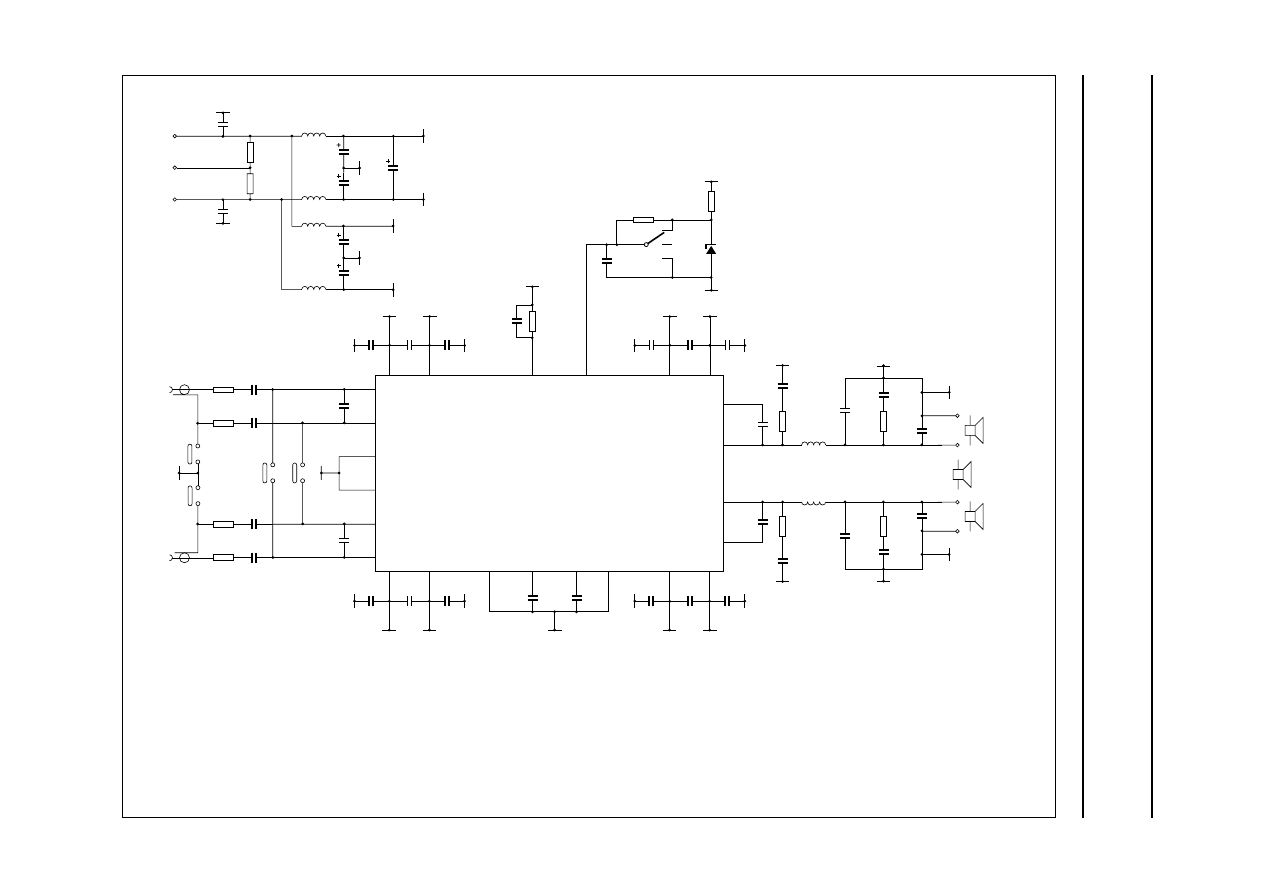
2002
Sep
25
19
Philips Semiconductors
Product specification
2
×
80
W class-D po
w
er amplifier
TD
A8920
This text is here in white to force landscape pages to be rotated correctly when browsing through the pdf in the Acrobat reader.This text is here in
_
white to force landscape pages to be rotated correctly when browsing through the pdf in the Acrobat reader.This text is here inThis text is here in
white to force landscape pages to be rotated correctly when browsing through the pdf in the Acrobat reader. white to force landscape pages to be ...
ag
ewidth
MBL470
TDA8920TH
C20
330 pF
C10
100 nF
C12
100 nF
C11
220 nF
C9
220 nF
C8
220 nF
on
mute
off
R5
30 k
Ω
C17
470 nF
R7
5.6 k
Ω
C16
470 nF
R6
5.6 k
Ω
J4
(1)
J3
C21
330 pF
8
10
12
7
6
1
3
24
18
13
19
23
20
VDDA1 VSSA1
OSC
MODE
VDDA
VSSA
VSSA
9
11
2
5
15
OUT1
BOOT1
BOOT2
OUT2
16
21
22
4
IN1
+
IN1
−
IN2
+
IN2
−
SGND1
SGND
GND
GND
GND
C13
100 nF
C14
220 nF
C15
100 nF
14
17
VDDP1 VSSP1
VDDP
VDDA
VSSP
GND
GND
R4 39 k
Ω
R3
39 k
Ω
Z1
5.6 V
S1
GND
C34
100 nF
C35
220 nF
C36
100 nF
C32
220 nF
C33
47 pF
VSSA2
VDDA2
VSSD
STABI
PROT
HW
VSSA
VDDA
VSSP
GND
GND
C37
100 nF
C38
220 nF
C39
100 nF
C22
15 nF
C23
15 nF
C30
15 nF
C31
15 nF
C26
470 nF
C27
470 nF
R10
4.7
Ω
C24
560 pF
R11
4.7
Ω
C25
560 pF
R12
22
Ω
R13
22
Ω
C28
220 nF
C29
220 nF
L5
27
µ
H
L6
27
µ
H
VDDP2 VSSP2
VDDP
GND
GND
GND
GND
SGND
SGND
SE 4
Ω
SE 4
Ω
OUT1
−
OUT1
+
OUT2
−
OUT2
+
VSSP
GND
GND
SGND2
J2
(4)
J1
in 1
in 2
C18
470 nF
R8
5.6 k
Ω
C19
470 nF
R9
5.6 k
Ω
(2)
BTL 8
Ω
L1
BEAD
L2
BEAD
C1
470
µ
F
C3
47
µ
F
C2
470
µ
F
100 nF
C6
100 nF
C7
VDDP
VSSP
GND
R1
(3)
10 k
Ω
R2
(3)
9.1 k
Ω
VDDA
VSSA
C4
47
µ
F
C5
47
µ
F
GND
GND
GND
GND
VSS
VDD
L3
BEAD
L4
BEAD
+
25 V
−
25 V
Fig.9 Single-chip class-D audio amplifier application diagram.
(4) In case of HUM close J1 and J2.
(5) Every decoupling to ground (plane) must be made as close
as possible to the pin.
(6) To handle 20 Hz under all conditions in stereo SE mode, the
external power supply needs to have a capacitance of at
least 4700
µ
F per supply line; V
P
=
±
27 V (max).
(1) BTL: remove in2, R8, R9, C18, C19, C21 and
close J3 and J4.
(2) BTL: connect loudspeaker between OUT1+ and
OUT2
−
.
(3) BTL: R1 and R2 are only required when an
asymmetrical supply is used (V
SS
= 0 V).
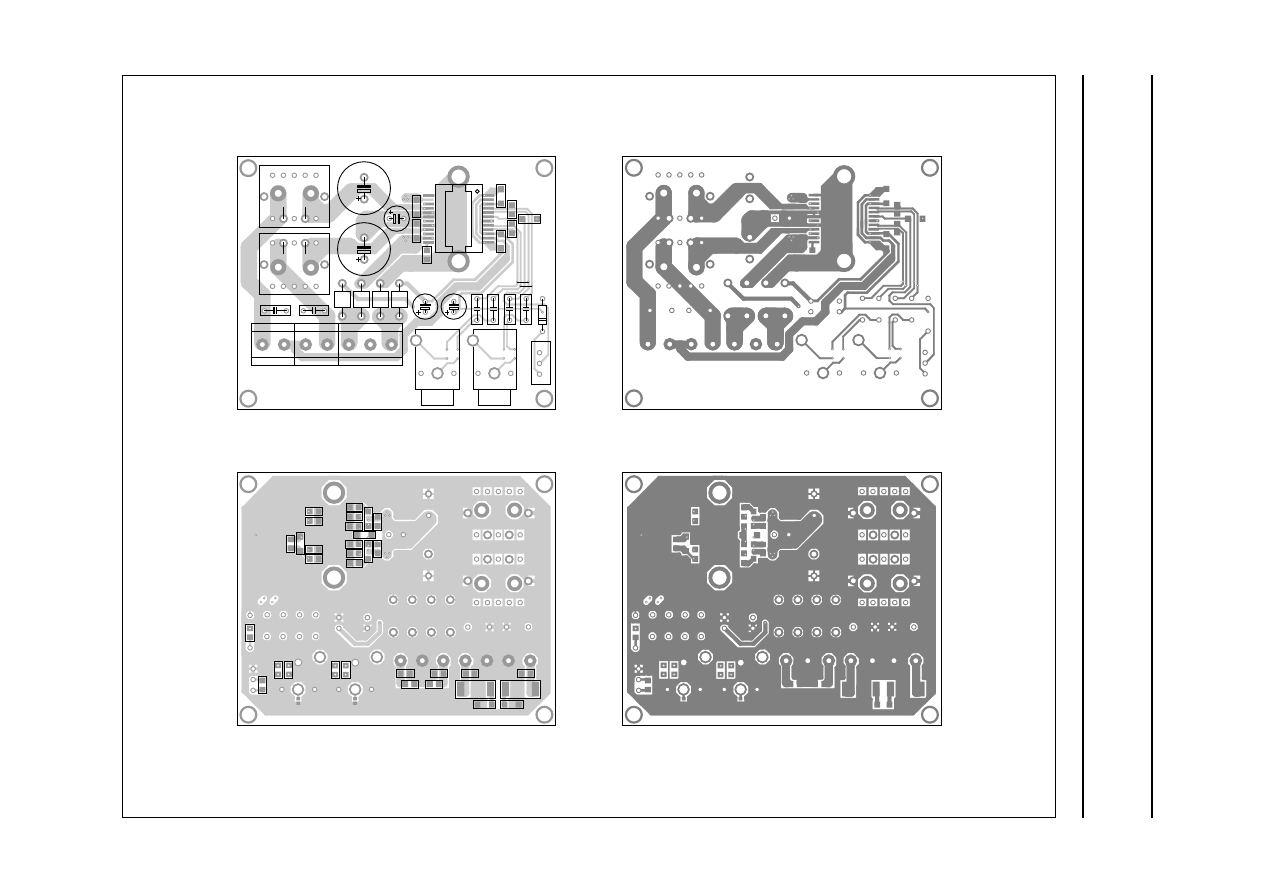
2002
Sep
25
20
Philips Semiconductors
Product specification
2
×
80
W class-D po
w
er amplifier
TD
A8920
This text is here in white to force landscape pages to be rotated correctly when browsing through the pdf in the Acrobat reader.This text is here in
_
white to force landscape pages to be rotated correctly when browsing through the pdf in the Acrobat reader.This text is here inThis text is here in
white to force landscape pages to be rotated correctly when browsing through the pdf in the Acrobat reader. white to force landscape pages to be ...
handbook, full pagewidth
−
Out1
+
VSS
In1
In2
S1
Z1
C19
C18
C16
C17
C26
C27
C4
C1
U1
1-2002
PCB version 4
J4
J3
C3
C38
C14
C33
C29
R13
R12
C28
R1
R2
R5
R11
R10
R6
R7
R9
R8
R4
R3
J1
J2
C6
C7
C34
C25
C24
C23
C22
C9
C12
C36
C37
C39
C15
C32
C13
C10
C31
C30
C35
C21
C20
C8
C11
C2
C5
L3
L2
L4
L5
L6
L1
On
Off
TDA8920/21/22/23/24TH
state of D art
PHILIPS SEMICONDUCTORS
VDD GND
−
Out2
+
MBL496
Top copper
Top silk screen
Bottom copper
Bottom silk screen
Fig.10 Printed-circuit board layout for the TDA8920TH.
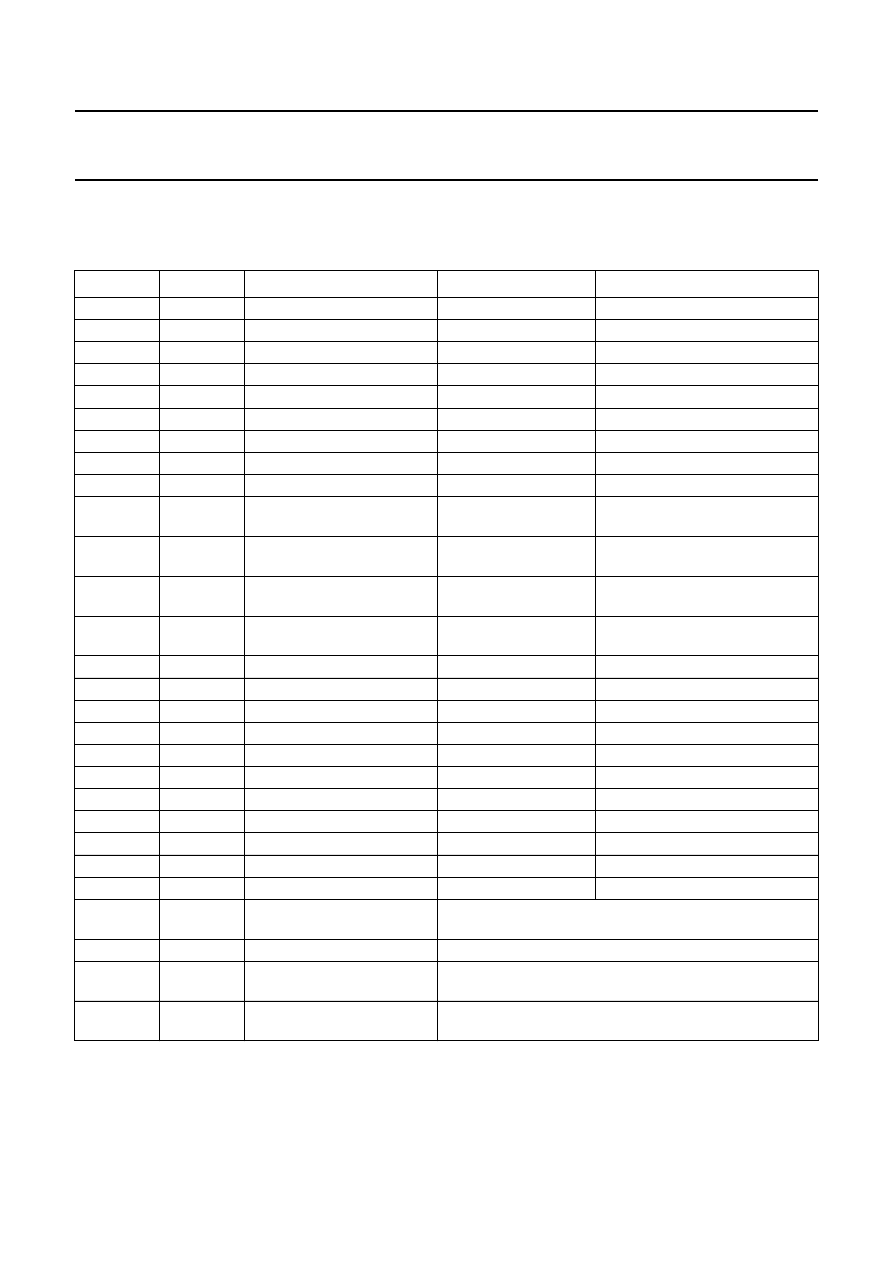
2002 Sep 25
21
Philips Semiconductors
Product specification
2
×
80 W class-D power amplifier
TDA8920
16.11 Reference design: bill of materials
Table 1
Single-chip class-D audio amplifier printed-circuit board (version 4; 01-2002) for TDA8920TH
(see Figs 9 and 10)
BOM ITEM
QUANTITY
REFERENCE
PART
DESCRIPTION
1
1
U1
TDA8920TH
Philips Semiconductors B.V.
2
2
in1 and in2
cinch inputs
Farnell 152-396
3
2
out1 and out2
output connector
Augat 5KEV-02
4
1
V
DD
, GND and V
SS
supply connector
Augat 5KEV-03
5
2
L6 and L5
27
µ
H
EP13 or 16RHBP
6
4
L1, L2, L3 and L4
BEAD
Murata BL01RN1-A62
7
1
S1
PCB switch
Knitter ATE1E M-O-M
8
1
Z1
5V6
BZX 79C5V6 DO-35
9
2
C1 and C2
470
µ
F/35 V
Panasonic M series ECA1VM471
10
3
C3, C4 and C5
47
µ
F 63 V
Panasonic NHG series
ECA1JHG470
11
6
C16, C17, C18, C19, C26
and C27
470 nF 63 V
MKT EPCOS B32529- 0474- K
12
9
C8, C9, C11, C14, C28, C29,
C32, C35 and C38
220 nF 63 V
SMD 1206
13
10
C6, C7, C10, C12, C13, C15,
C34, C36, C37 and C39
100 nF 50 V
SMD 0805
14
2
C20 and C21
330 pF 50 V
SMD 0805
15
4
C22, C23, C30 and C31
15 nF 50 V
SMD 0805
16
2
C24, C25
560 pF 100 V
SMD 0805
17
1
C33
47 pF 25V
SMD 0805
18
2
R4 and R3
39 k
Ω
0.1 W
SMD 0805
19
1
R5
30 k
Ω
0.1 W
SMD 1206
20
1
R1
10 k
Ω
0.1 W; optional
SMD 0805
21
1
R2
9.1 k
Ω
0.1 W; optional
SMD 0805
22
4
R6, R7, R8 and R9
5.6 k
Ω
0.1 W
SMD 0805
23
2
R13 and R12
22
Ω
1 W
SMD 2512
24
2
R10 and R11
4.7
Ω
0.25 W
SMD 1206
25
2
J1 and J2
solder dot jumpers for ground reference in case of HUM
(60 Hz noise)
26
2
J3 and J4
wire jumpers for BTL application
27
1
heatsink
30 mm SK400; OK for maximum music dissipation;
1/8 Prated (2
×
75 W/8) in 2
×
4
Ω
at T
amb
= 70
°
C
28
1
printed-circuit board material
1.6 mm thick epoxy FR4 material, double sided 35
µ
m
copper; clearances 300
µ
m; minimum copper track 400
µ
m
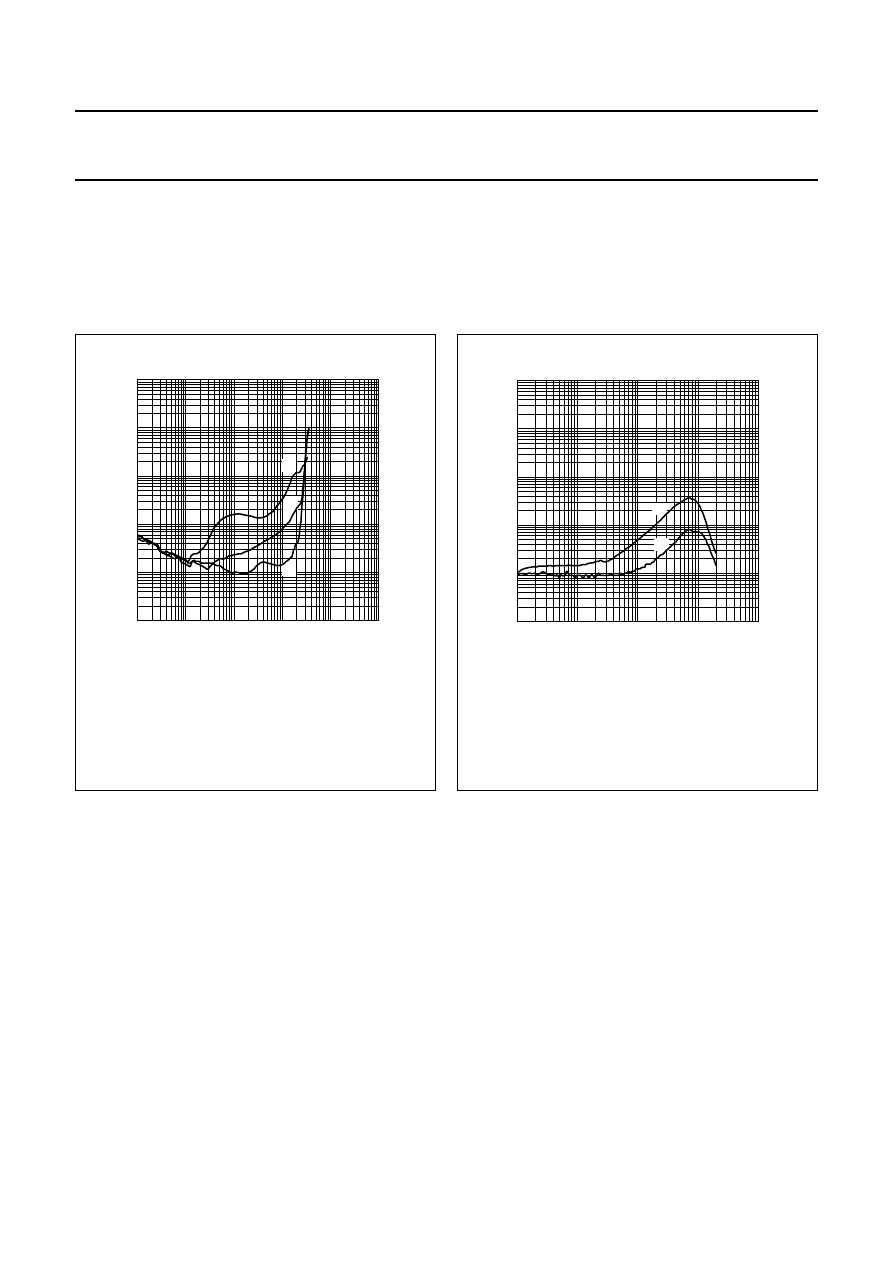
2002 Sep 25
22
Philips Semiconductors
Product specification
2
×
80 W class-D power amplifier
TDA8920
16.12 Curves measured in the reference design
The curves illustrated in Figs 19 and 20 are measured with a restive load impedance. Spread in RI (e.g. due to the
frequency characteristics of the loudspeaker) can trigger the maximum current protection circuit; see Section 16.6.
The curves illustrated in Figs 29 and 30 show the effects of supply pumping when only one single-ended channel is
driven with a low frequency signal; see Section 16.7.
handbook, halfpage
10
2
10
1
10
−
1
10
−
3
10
−
2
MBL471
10
−
2
10
−
1
1
Po (W)
THD
+
N
(%)
10
10
2
10
3
(1)
(2)
(3)
Fig.11 THD + N as a function of output power.
2
×
8
Ω
SE; V
P
=
±
25 V.
(1) 10 kHz.
(2) 1 kHz.
(3) 100 Hz.
handbook, halfpage
MBL472
10
10
2
10
3
10
4
10
5
10
2
10
1
10
−
1
10
−
3
10
−
2
fi (Hz)
THD
+
N
(%)
(1)
(2)
Fig.12 THD + N as a function of input frequency.
2
×
8
Ω
SE; V
P
=
±
25 V.
(1) P
o
= 10 W.
(2) P
o
= 1 W.

2002 Sep 25
23
Philips Semiconductors
Product specification
2
×
80 W class-D power amplifier
TDA8920
handbook, halfpage
10
2
10
1
10
−
1
10
−
3
10
−
2
MBL473
10
−
2
10
−
1
1
Po (W)
THD
+
N
(%)
10
10
2
10
3
(1)
(2)
(3)
Fig.13 THD + N as a function of output power.
2
×
4
Ω
SE; V
P
=
±
25 V.
(1) 10 kHz.
(2) 1 kHz.
(3) 100 Hz.
handbook, halfpage
MBL474
10
10
2
10
3
10
4
10
5
10
2
10
1
10
−
1
10
−
3
10
−
2
fi (Hz)
THD
+
N
(%)
(1)
(2)
Fig.14 THD + N as a function of input frequency.
2
×
4
Ω
SE; V
P
=
±
25 V.
(1) P
o
= 10 W.
(2) P
o
= 1 W.
handbook, halfpage
10
2
10
1
10
−
1
10
−
3
10
−
2
MBL475
10
−
2
10
−
1
1
Po (W)
THD
+
N
(%)
10
10
2
10
3
(1)
(2)
(3)
Fig.15 THD + N as a function of output power.
1
×
8
Ω
BTL; V
P
=
±
25 V.
(1) 10 kHz.
(2) 1 kHz.
(3) 100 Hz.
handbook, halfpage
MBL476
10
10
2
10
3
10
4
10
5
10
2
10
1
10
−
1
10
−
3
10
−
2
fi (Hz)
THD
+
N
(%)
(1)
(2)
Fig.16 THD + N as a function of input frequency.
1
×
8
Ω
BTL; V
P
=
±
25 V.
(1) P
o
= 10 W.
(2) P
o
= 1 W.

2002 Sep 25
24
Philips Semiconductors
Product specification
2
×
80 W class-D power amplifier
TDA8920
handbook, halfpage
0
25
5
10
15
20
MBL477
10
−
2
10
−
1
1
Po (W)
Pdiss
(W)
10
10
2
10
3
(1)
(2)
(3)
Fig.17 Power dissipation as a function of output
power.
V
P
=
±
25 V; f
i
= 1 kHz.
(1) 2
×
4
Ω
SE.
(2) 1
×
8
Ω
BTL.
(3) 2
×
8
Ω
SE.
handbook, halfpage
0
(3)
(1)
(2)
150
100
0
20
40
60
80
30
η
(%)
Po (W)
60
90
120
MBL478
Fig.18 Efficiency as a function of output power.
V
P
=
±
25 V; f
i
= 1 kHz.
(1) 2
×
4
Ω
SE.
(2) 1
×
8
Ω
BTL.
(3) 2
×
8
Ω
SE.
handbook, halfpage
10
(4)
(2)
35
200
0
40
80
120
160
15
Po
(W)
VDD (V)
20
25
30
MBL479
(3)
(1)
Fig.19 Output power as a function of supply
voltage.
THD + N = 0.5%; f = 1 kHz.
(1) 1
×
4
Ω
BTL.
(2) 1
×
8
Ω
BTL.
(3) 2
×
4
Ω
SE.
(4) 2
×
8
Ω
SE.
handbook, halfpage
10
(1)
(4)
(3)
(2)
35
200
0
40
80
120
160
15
Po
(W)
VDD (V)
20
25
30
MBL480
Fig.20 Output power as a function of supply
voltage.
THD + N = 10%; f = 1 kHz.
(1) 1
×
4
Ω
BTL.
(2) 1
×
8
Ω
BTL.
(3) 2
×
4
Ω
SE.
(4) 2
×
8
Ω
SE.
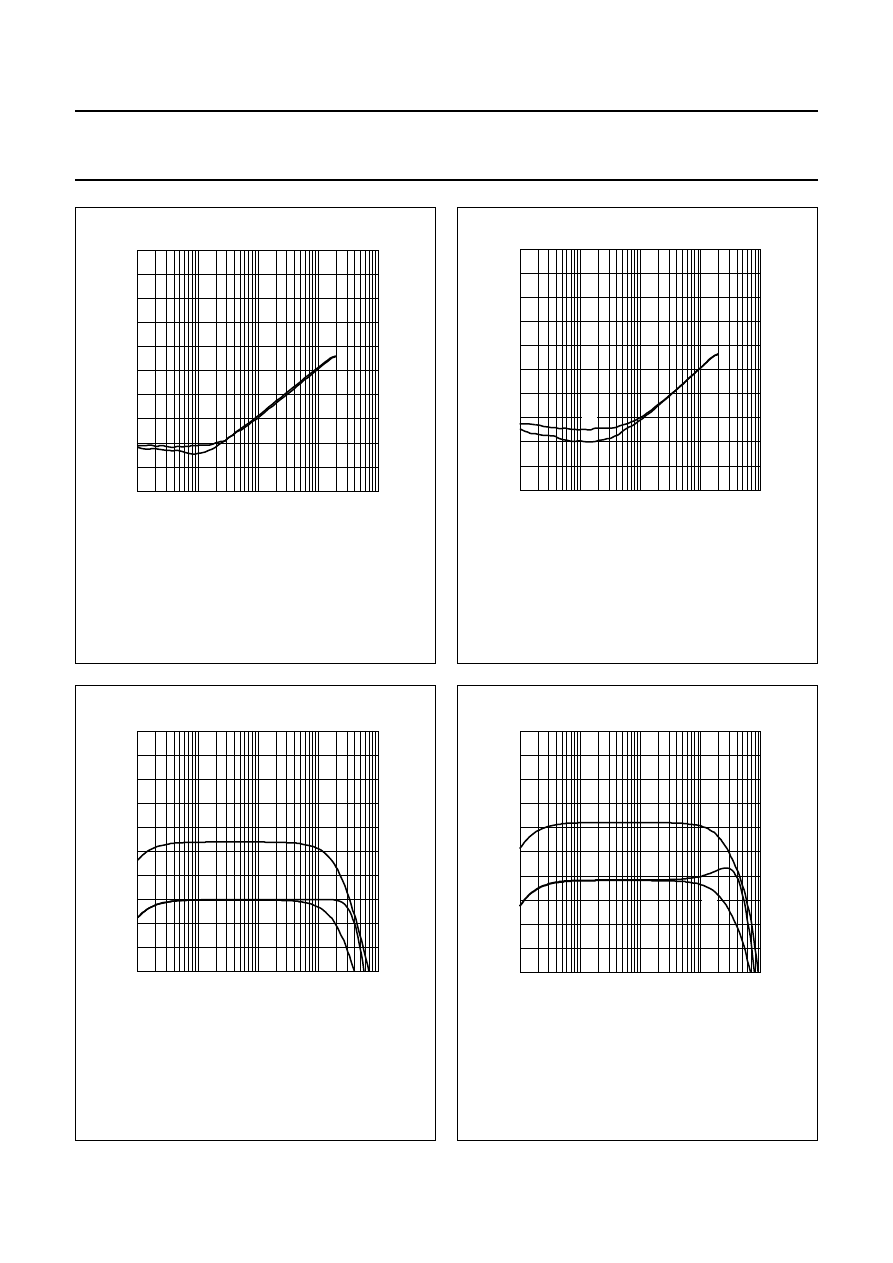
2002 Sep 25
25
Philips Semiconductors
Product specification
2
×
80 W class-D power amplifier
TDA8920
handbook, halfpage
−
100
0
−
80
−
60
−
40
−
20
MBL481
10
2
10
fi (Hz)
α
cs
(dB)
10
3
10
4
10
5
(1)
(2)
Fig.21 Channel separation as a function of input
frequency.
2
×
8
Ω
SE; V
P
=
±
25 V.
(1) P
out
= 1 W.
(2) P
out
= 10 W.
handbook, halfpage
−
100
0
−
80
−
60
−
40
−
20
MBL482
10
2
10
fi (Hz)
α
cs
(dB)
10
3
10
4
10
5
(2)
(1)
Fig.22 Channel separation as a function of input
frequency.
2
×
4
Ω
SE; V
P
=
±
25 V.
(1) P
out
= 1 W.
(2) P
out
= 10 W.
handbook, halfpage
20
45
25
30
35
40
MBL483
10
2
10
fi (Hz)
G
(dB)
10
3
10
4
10
5
(1)
(2)
(3)
Fig.23 Gain as a function of input frequency.
V
P
=
±
25 V; V
i
= 100 mV; R
s
= 10 k
Ω
; C
i
= 330 pF.
(1) 1
×
8
Ω
BTL.
(2) 2
×
8
Ω
SE.
(3) 2
×
4
Ω
SE.
handbook, halfpage
20
45
25
30
35
40
MBL484
10
2
10
fi (Hz)
G
(dB)
10
3
10
4
10
5
(2)
(3)
(1)
Fig.24 Gain as a function of input frequency.
V
P
=
±
25 V; V
i
= 100 mV; R
s
= 0 k
Ω
.
(1) 1
×
8
Ω
BTL.
(2) 2
×
8
Ω
SE.
(3) 2
×
4
Ω
SE.
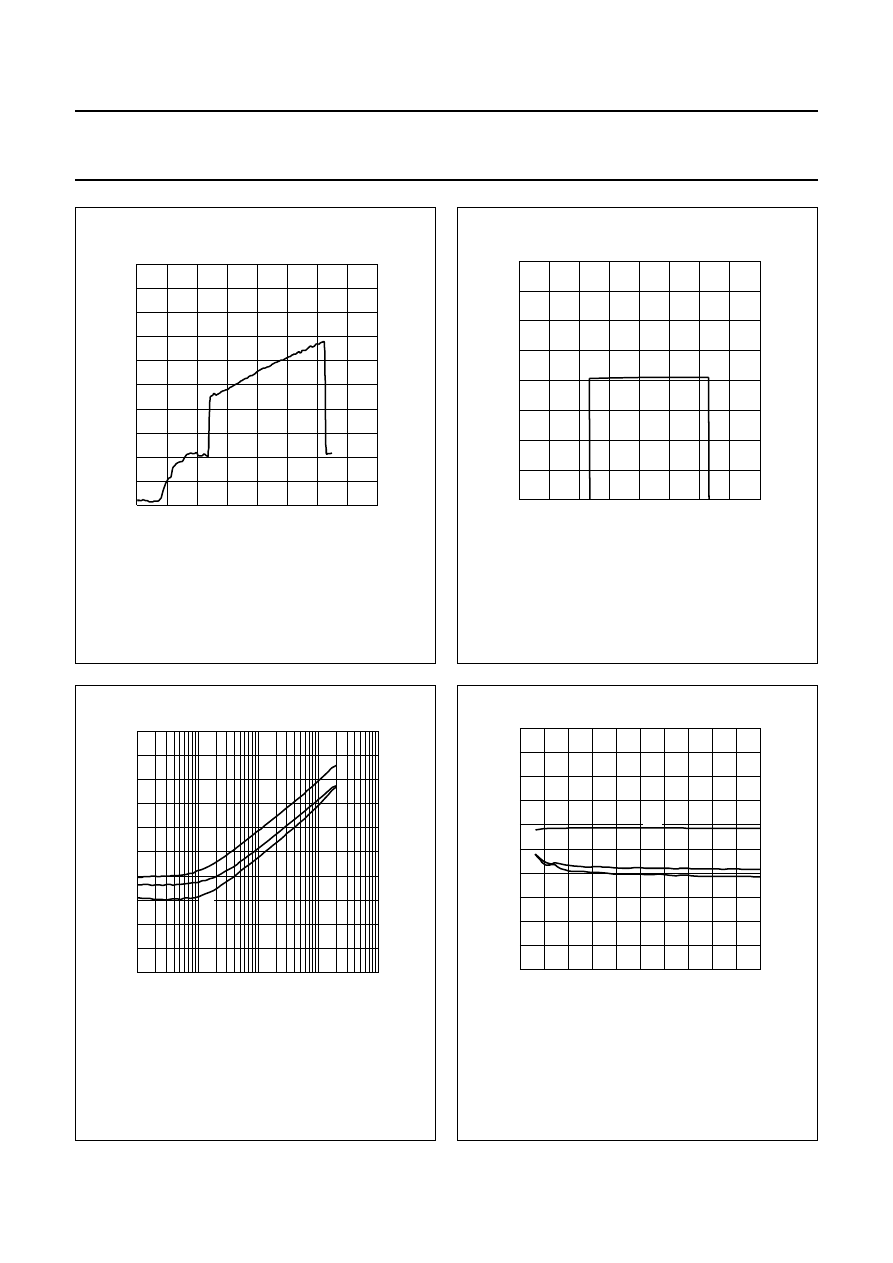
2002 Sep 25
26
Philips Semiconductors
Product specification
2
×
80 W class-D power amplifier
TDA8920
handbook, halfpage
0
10
20
VDD (V)
Iq
(mA)
40
100
0
80
30
60
40
20
MBL485
Fig.25 Quiescent current as a function of supply
voltage.
R
L
is open-circuit.
handbook, halfpage
0
10
VDD (V)
fCLK
(kHz)
20
40
330
320
300
290
310
30
MBL486
Fig.26 Clock frequency as a function of supply
voltage.
R
L
is open-circuit.
handbook, halfpage
−
100
0
−
80
−
60
−
40
−
20
MBL487
10
2
10
fi (Hz)
SVRR
(dB)
10
3
10
4
10
5
(1)
(2)
(3)
Fig.27 SVRR as a function of input frequency.
V
P
=
±
25 V; V
ripple
= 2 V (p-p) with respect to ground.
(1) Both supply lines in anti-phase.
(2) Both supply lines in phase.
(3) One supply line rippled.
handbook, halfpage
0
5
0
−
100
−
80
−
60
−
40
−
20
1
(3)
SVRR
(dB)
Vripple(p-p) (V)
2
3
4
MBL488
(2)
(1)
Fig.28 SVRR as a function of V
ripple(p-p)
.
V
P
=
±
25 V; V
ripple (P-P)
with respect to ground.
(1) f
ripple
= 1 kHz.
(2) f
ripple
= 100 Hz.
(3) f
ripple
= 10 Hz.
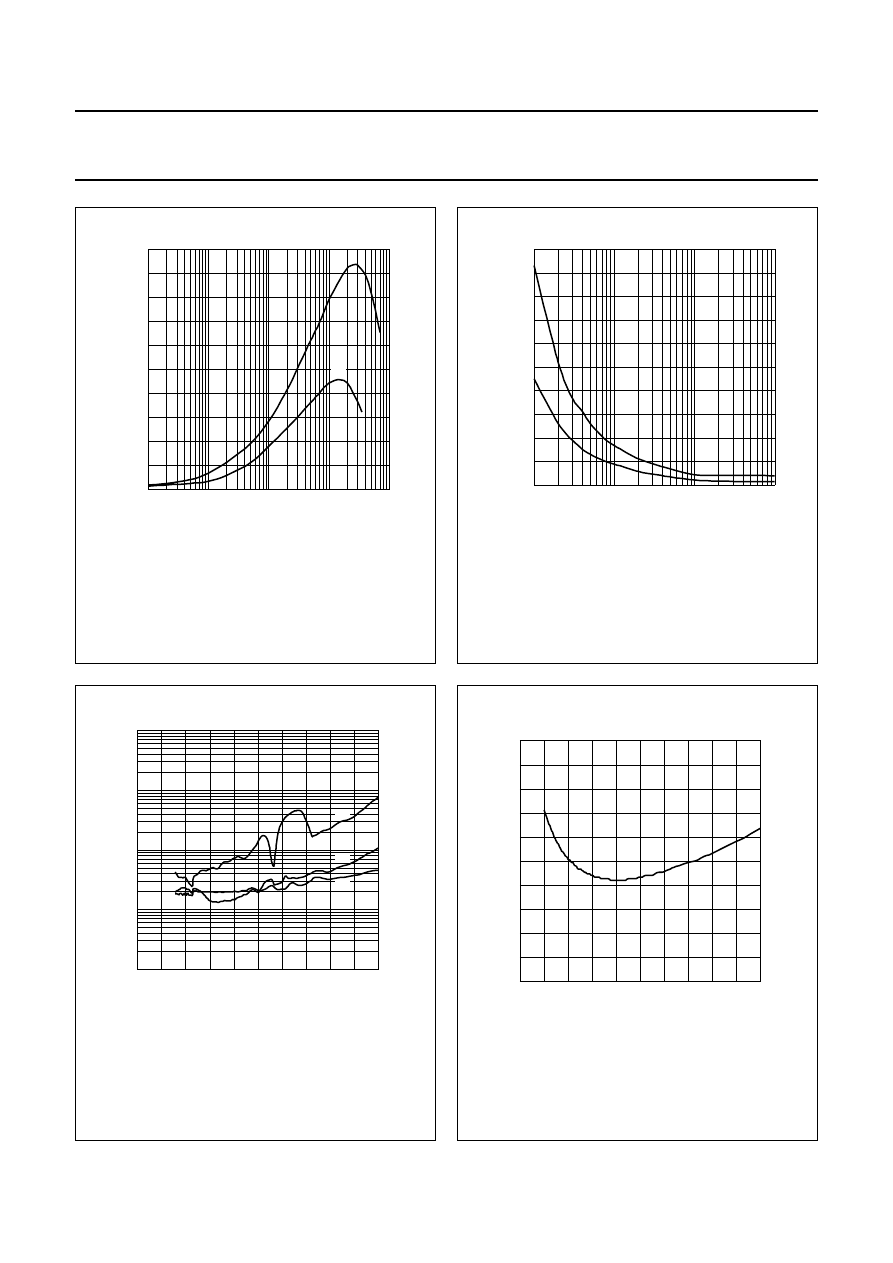
2002 Sep 25
27
Philips Semiconductors
Product specification
2
×
80 W class-D power amplifier
TDA8920
handbook, halfpage
0
10
2
4
6
8
MBL489
10
−
1
10
−
2
Po (W)
Vripple(p-p)
(V)
1
10
10
2
(1)
(2)
Fig.29 Supply voltage ripple as a function of output
power.
V
P
=
±
25 V; 3000
µ
F per supply line; f = 10 Hz.
(1) 1
×
4
Ω
SE.
(2) 1
×
8
Ω
SE.
handbook, halfpage
10
0
10
10
4
MBL490
10
2
10
3
fi (Hz)
Vripple(p-p)
(V)
2
4
6
8
(2)
(1)
Fig.30 Supply voltage ripple as a function of input
frequency.
V
P
=
±
25 V; 3000
µ
F per supply line.
(1) P
out
= 30 W into 1
×
4
Ω
SE.
(2) P
out
= 15 W into 1
×
8
Ω
SE.
handbook, halfpage
600
100
fCLK (kHz)
THD
+
N
(%)
200
300
400
500
10
1
10
−
1
10
−
2
10
−
3
MBL491
(1)
(2)
(2)
(3)
Fig.31 THD + N as a function of clock frequency.
V
P
=
±
25 V; P
o
= 1 W into 8
Ω
.
(1) 10 Hz.
(2) 1 kHz.
(3) 100 Hz.
handbook, halfpage
100
600
150
0
30
60
90
120
200
Iq
(mA)
fCLK (kHz)
300
400
500
MBL493
Fig.32 Quiescent current as a function of clock
frequency.
V
P
=
±
25 V; R
L
is open-circuit.
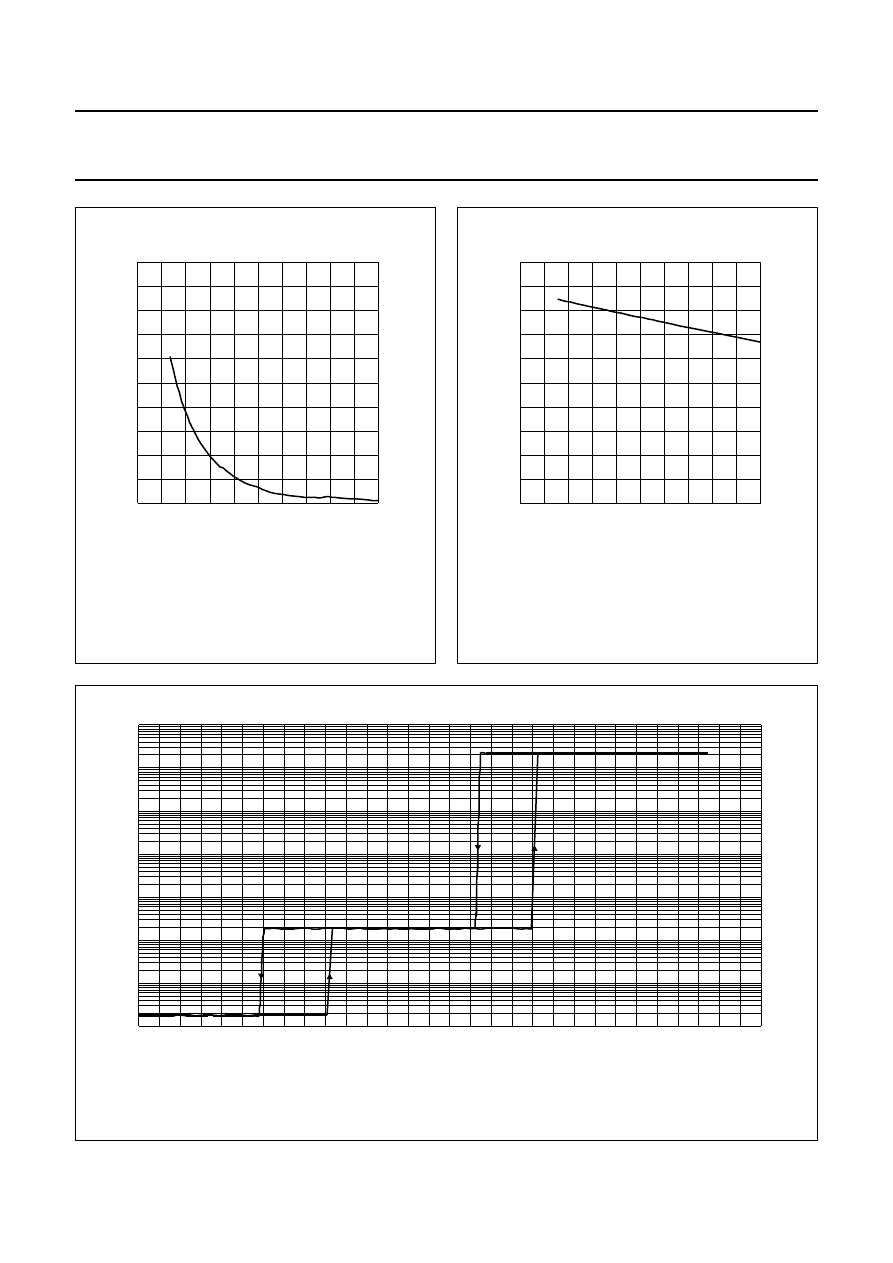
2002 Sep 25
28
Philips Semiconductors
Product specification
2
×
80 W class-D power amplifier
TDA8920
handbook, halfpage
100
600
1000
0
200
400
600
800
200
Vres
(mV)
fCLK (kHz)
300
400
500
MBL494
Fig.33 PWM residual voltage as a function of clock
frequency.
V
P
=
±
25 V; R
L
= 8
Ω
.
handbook, halfpage
100
600
50
0
10
20
30
40
200
Po
(W)
fCLK (kHz)
300
400
500
MBL495
Fig.34 Output power as a function of clock
frequency.
V
P
=
±
25 V; R
L
= 8
Ω
; f = 1 kHz; THD + N = 10%.
handbook, full pagewidth
0
1
5
6
4
Vmode (V)
2
Vo
(V)
3
10
−
1
10
−
2
10
−
3
10
−
4
10
−
5
10
−
6
10
1
MLD831
Fig.35 Output voltage as a function of mode voltage.
V
i
= 100 mV; f = 1 kHz.
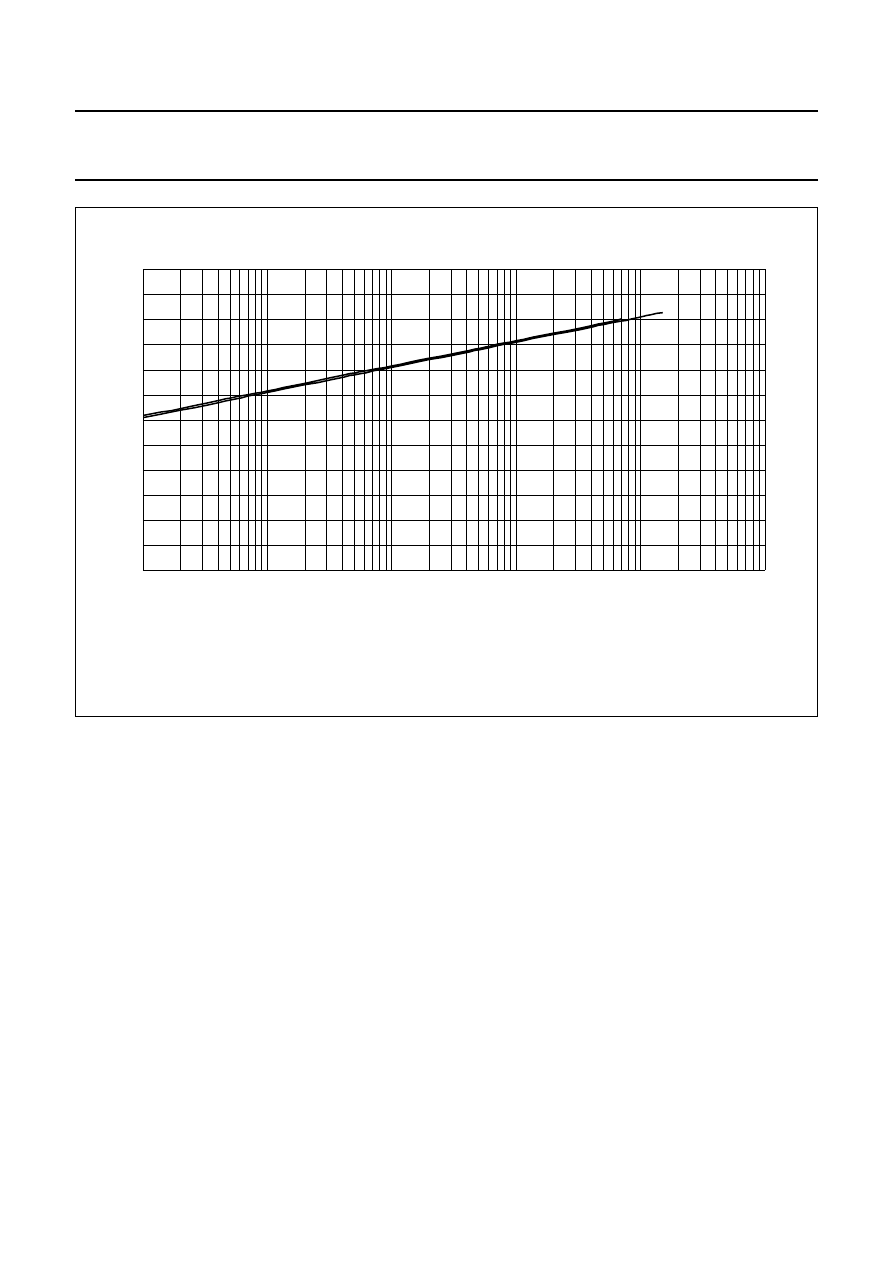
2002 Sep 25
29
Philips Semiconductors
Product specification
2
×
80 W class-D power amplifier
TDA8920
handbook, full pagewidth
0
40
120
80
MLD832
10
−
2
10
−
1
1
(1)
(2)
Po (W)
10
S/N
(dB)
10
2
10
3
Fig.36 Signal-to-noise ratio as a function of output power.
V
P
=
±
25 V; R
s
= 10 k
Ω
.
(1) 2
×
4
Ω
SE.
(2) 1
×
8
Ω
BTL.
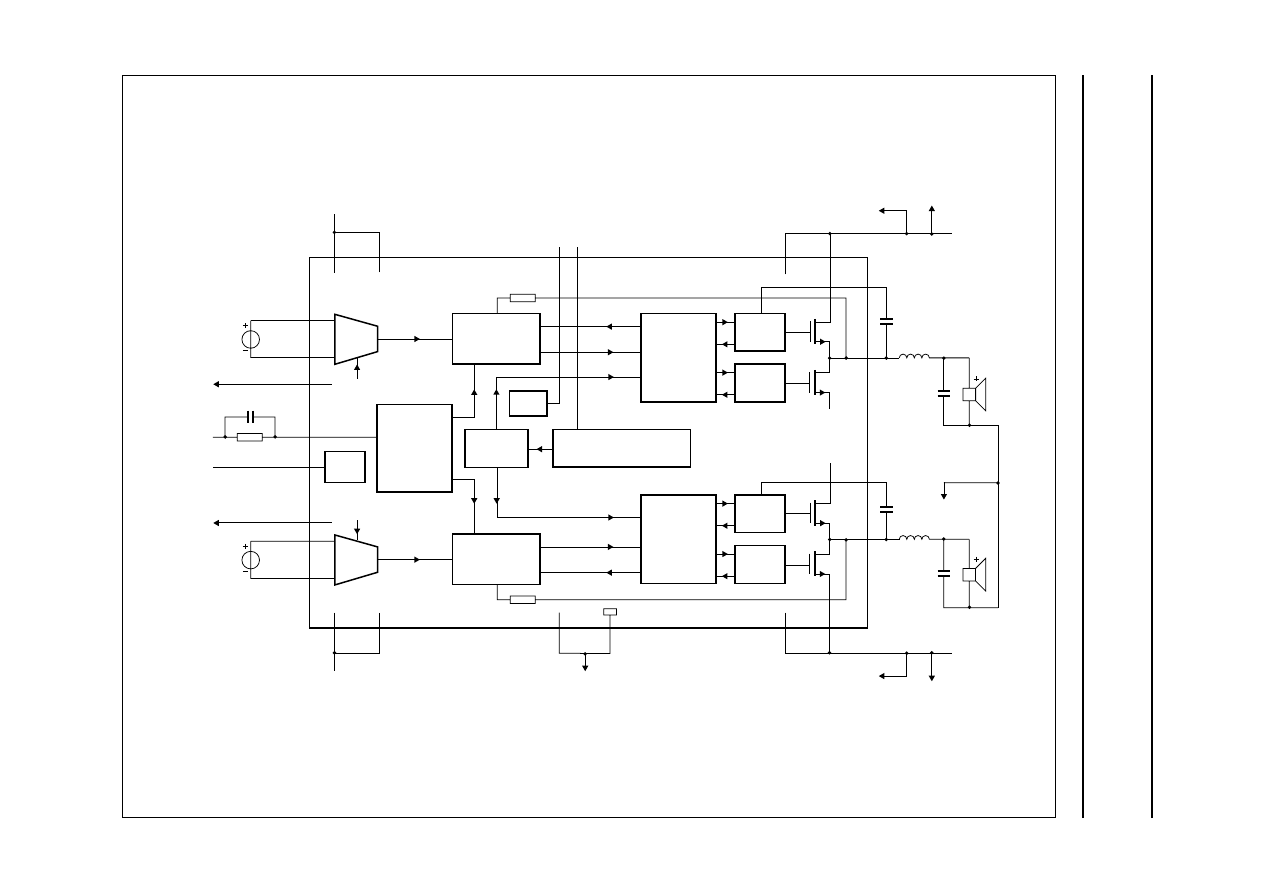
2002
Sep
25
30
Philips Semiconductors
Product specification
2
×
80
W class-D po
w
er amplifier
TD
A8920
This text is here in white to force landscape pages to be rotated correctly when browsing through the pdf in the Acrobat reader.This text is here in
_
white to force landscape pages to be rotated correctly when browsing through the pdf in the Acrobat reader.This text is here inThis text is here in
white to force landscape pages to be rotated correctly when browsing through the pdf in the Acrobat reader. white to force landscape pages to be ...
handbook, full pagewidth
OUT1
VSSP1
VDDP2
DRIVER
HIGH
MBL464
OUT2
BOOT2
TDA8920TH
BOOT1
DRIVER
LOW
RELEASE1
SWITCH1
ENABLE1
CONTROL
AND
HANDSHAKE
PWM
MODULATOR
RFB
RFB
MANAGER
OSCILLATOR
TEMPERATURE SENSOR
CURRENT PROTECTION
STABI
MODE
ROSC
VSSA
Vmode
COSC
INPUT
STAGE
mute
9
8
IN1
−
IN1
+
22
21
20
17
16
15
VSSP2
VSSP1
DRIVER
HIGH
DRIVER
LOW
RELEASE2
SWITCH2
ENABLE2
CONTROL
AND
HANDSHAKE
PWM
MODULATOR
11
SGND1
7
OSC
2
SGND2
SGND
SGND
6
MODE
INPUT
STAGE
mute
5
4
IN2
−
IN2
+
Vin2
Vin1
19
24
VSSD
VSSA
VSSP
0 V
VSSA
−
25 V
VDDP
VDDA
+
25 V
HW
1
VSSA2
VSSA
12
VSSA1
3
VDDA2
VDDA
10
VDDA1
23
13
18
14
VDDP2
PROT
STABI
VDDP1
SGND
Fig.37 Typical application schematic of TDA8920TH.
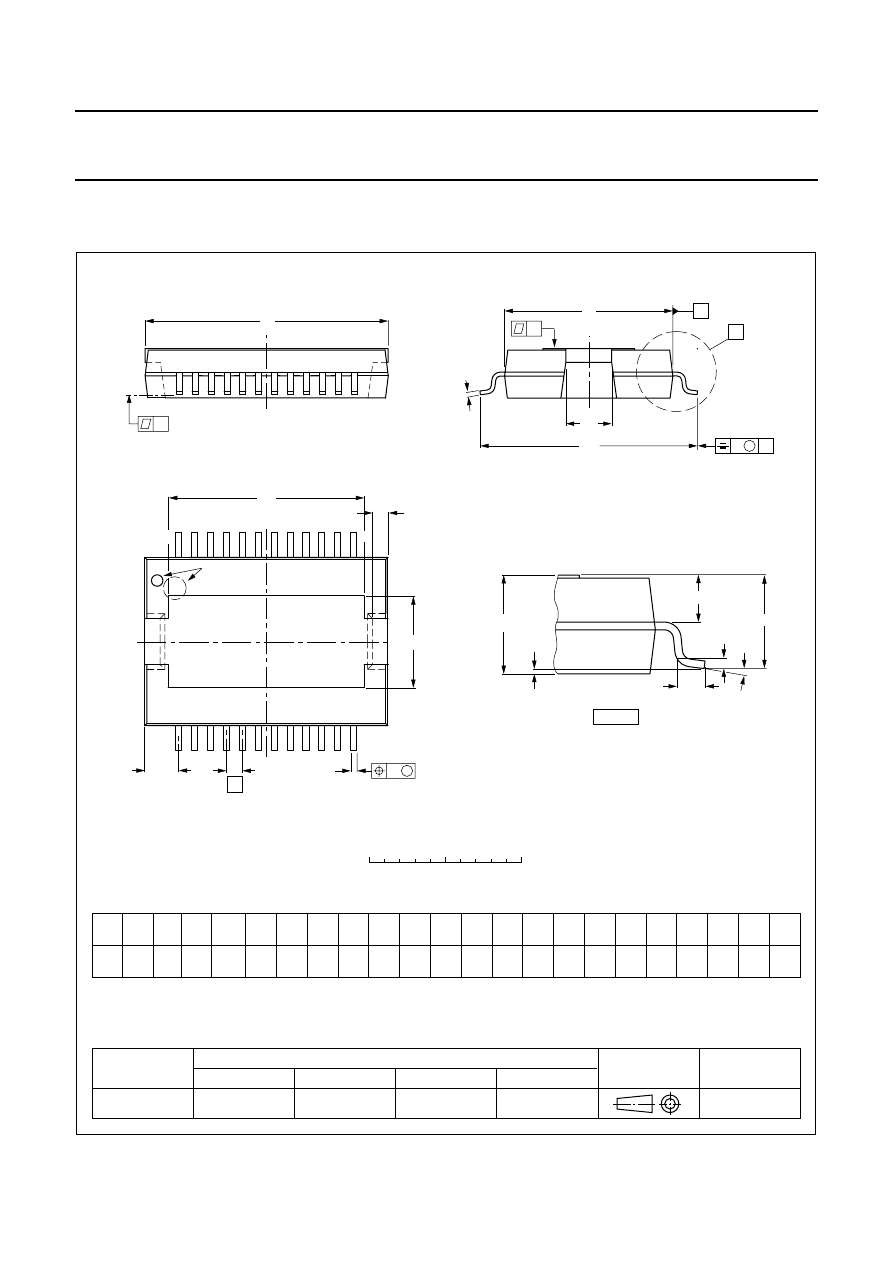
2002 Sep 25
31
Philips Semiconductors
Product specification
2
×
80 W class-D power amplifier
TDA8920
17 PACKAGE OUTLINE
UNIT
A4
(1)
REFERENCES
OUTLINE
VERSION
EUROPEAN
PROJECTION
ISSUE DATE
02-01-30
IEC
JEDEC
JEITA
mm
+
0.08
−
0.04
3.5
0.35
DIMENSIONS (mm are the original dimensions)
Notes
1. Limits per individual lead.
2. Plastic or metal protrusions of 0.25 mm maximum per side are not included.
SOT566-3
0
5
10 mm
scale
HSOP24: plastic, heatsink small outline package; 24 leads; low stand-off height
SOT566-3
A
max.
detail X
A2
3.5
3.2
D2
1.1
0.9
HE
14.5
13.9
Lp
1.1
0.8
Q
1.7
1.5
2.7
2.2
v
0.25
w
0.25
y
Z
8
°
0
°
θ
0.07
x
0.03
D1
13.0
12.6
E1
6.2
5.8
E2
2.9
2.5
bp
c
0.32
0.23
e
1
D
(2)
16.0
15.8
E
(2)
11.1
10.9
0.53
0.40
A3
A4
A2
(A3)
Lp
θ
A
Q
D
y
x
HE
E
c
v
M
A
X
A
bp
w
M
Z
D1
D2
E2
E1
e
24
13
1
12
pin 1 index

2002 Sep 25
32
Philips Semiconductors
Product specification
2
×
80 W class-D power amplifier
TDA8920
18 SOLDERING
18.1
Introduction to soldering surface mount
packages
This text gives a very brief insight to a complex technology.
A more in-depth account of soldering ICs can be found in
our
“Data Handbook IC26; Integrated Circuit Packages”
(document order number 9398 652 90011).
There is no soldering method that is ideal for all surface
mount IC packages. Wave soldering can still be used for
certain surface mount ICs, but it is not suitable for fine pitch
SMDs. In these situations reflow soldering is
recommended.
18.2
Reflow soldering
Reflow soldering requires solder paste (a suspension of
fine solder particles, flux and binding agent) to be applied
to the printed-circuit board by screen printing, stencilling or
pressure-syringe dispensing before package placement.
Several methods exist for reflowing; for example,
convection or convection/infrared heating in a conveyor
type oven. Throughput times (preheating, soldering and
cooling) vary between 100 and 200 seconds depending
on heating method.
Typical reflow peak temperatures range from
215 to 250
°
C. The top-surface temperature of the
packages should preferable be kept below 220
°
C for
thick/large packages, and below 235
°
C for small/thin
packages.
18.3
Wave soldering
Conventional single wave soldering is not recommended
for surface mount devices (SMDs) or printed-circuit boards
with a high component density, as solder bridging and
non-wetting can present major problems.
To overcome these problems the double-wave soldering
method was specifically developed.
If wave soldering is used the following conditions must be
observed for optimal results:
•
Use a double-wave soldering method comprising a
turbulent wave with high upward pressure followed by a
smooth laminar wave.
•
For packages with leads on two sides and a pitch (e):
– larger than or equal to 1.27 mm, the footprint
longitudinal axis is preferred to be parallel to the
transport direction of the printed-circuit board;
– smaller than 1.27 mm, the footprint longitudinal axis
must be parallel to the transport direction of the
printed-circuit board.
The footprint must incorporate solder thieves at the
downstream end.
•
For packages with leads on four sides, the footprint must
be placed at a 45
°
angle to the transport direction of the
printed-circuit board. The footprint must incorporate
solder thieves downstream and at the side corners.
During placement and before soldering, the package must
be fixed with a droplet of adhesive. The adhesive can be
applied by screen printing, pin transfer or syringe
dispensing. The package can be soldered after the
adhesive is cured.
Typical dwell time is 4 seconds at 250
°
C.
A mildly-activated flux will eliminate the need for removal
of corrosive residues in most applications.
18.4
Manual soldering
Fix the component by first soldering two
diagonally-opposite end leads. Use a low voltage (24 V or
less) soldering iron applied to the flat part of the lead.
Contact time must be limited to 10 seconds at up to
300
°
C.
When using a dedicated tool, all other leads can be
soldered in one operation within 2 to 5 seconds between
270 and 320
°
C.

2002 Sep 25
33
Philips Semiconductors
Product specification
2
×
80 W class-D power amplifier
TDA8920
18.5
Suitability of surface mount IC packages for wave and reflow soldering methods
Notes
1. For more detailed information on the BGA packages refer to the
“(LF)BGA Application Note” (AN01026); order a copy
from your Philips Semiconductors sales office.
2. All surface mount (SMD) packages are moisture sensitive. Depending upon the moisture content, the maximum
temperature (with respect to time) and body size of the package, there is a risk that internal or external package
cracks may occur due to vaporization of the moisture in them (the so called popcorn effect). For details, refer to the
Drypack information in the
“Data Handbook IC26; Integrated Circuit Packages; Section: Packing Methods”.
3. These packages are not suitable for wave soldering. On versions with the heatsink on the bottom side, the solder
cannot penetrate between the printed-circuit board and the heatsink. On versions with the heatsink on the top side,
the solder might be deposited on the heatsink surface.
4. If wave soldering is considered, then the package must be placed at a 45
°
angle to the solder wave direction.
The package footprint must incorporate solder thieves downstream and at the side corners.
5. Wave soldering is suitable for LQFP, TQFP and QFP packages with a pitch (e) larger than 0.8 mm; it is definitely not
suitable for packages with a pitch (e) equal to or smaller than 0.65 mm.
6. Wave soldering is suitable for SSOP and TSSOP packages with a pitch (e) equal to or larger than 0.65 mm; it is
definitely not suitable for packages with a pitch (e) equal to or smaller than 0.5 mm.
PACKAGE
(1)
SOLDERING METHOD
WAVE
REFLOW
(2)
BGA, LBGA, LFBGA, SQFP, TFBGA, VFBGA
not suitable
suitable
HBCC, HBGA, HLQFP, HSQFP, HSOP, HTQFP, HTSSOP, HVQFN,
HVSON, SMS
not suitable
(3)
suitable
PLCC
(4)
, SO, SOJ
suitable
suitable
LQFP, QFP, TQFP
not recommended
(4)(5)
suitable
SSOP, TSSOP, VSO
not recommended
(6)
suitable

2002 Sep 25
34
Philips Semiconductors
Product specification
2
×
80 W class-D power amplifier
TDA8920
19 DATA SHEET STATUS
Notes
1. Please consult the most recently issued data sheet before initiating or completing a design.
2. The product status of the device(s) described in this data sheet may have changed since this data sheet was
published. The latest information is available on the Internet at URL http://www.semiconductors.philips.com.
DATA SHEET STATUS
(1)
PRODUCT
STATUS
(2)
DEFINITIONS
Objective data
Development
This data sheet contains data from the objective specification for product
development. Philips Semiconductors reserves the right to change the
specification in any manner without notice.
Preliminary data
Qualification
This data sheet contains data from the preliminary specification.
Supplementary data will be published at a later date. Philips
Semiconductors reserves the right to change the specification without
notice, in order to improve the design and supply the best possible
product.
Product data
Production
This data sheet contains data from the product specification. Philips
Semiconductors reserves the right to make changes at any time in order
to improve the design, manufacturing and supply. Changes will be
communicated according to the Customer Product/Process Change
Notification (CPCN) procedure SNW-SQ-650A.
20 DEFINITIONS
Short-form specification
The data in a short-form
specification is extracted from a full data sheet with the
same type number and title. For detailed information see
the relevant data sheet or data handbook.
Limiting values definition
Limiting values given are in
accordance with the Absolute Maximum Rating System
(IEC 60134). Stress above one or more of the limiting
values may cause permanent damage to the device.
These are stress ratings only and operation of the device
at these or at any other conditions above those given in the
Characteristics sections of the specification is not implied.
Exposure to limiting values for extended periods may
affect device reliability.
Application information
Applications that are
described herein for any of these products are for
illustrative purposes only. Philips Semiconductors make
no representation or warranty that such applications will be
suitable for the specified use without further testing or
modification.
21 DISCLAIMERS
Life support applications
These products are not
designed for use in life support appliances, devices, or
systems where malfunction of these products can
reasonably be expected to result in personal injury. Philips
Semiconductors customers using or selling these products
for use in such applications do so at their own risk and
agree to fully indemnify Philips Semiconductors for any
damages resulting from such application.
Right to make changes
Philips Semiconductors
reserves the right to make changes, without notice, in the
products, including circuits, standard cells, and/or
software, described or contained herein in order to
improve design and/or performance. Philips
Semiconductors assumes no responsibility or liability for
the use of any of these products, conveys no licence or title
under any patent, copyright, or mask work right to these
products, and makes no representations or warranties that
these products are free from patent, copyright, or mask
work right infringement, unless otherwise specified.

2002 Sep 25
35
Philips Semiconductors
Product specification
2
×
80 W class-D power amplifier
TDA8920
NOTES

© Koninklijke Philips Electronics N.V. 2002
SCA74
All rights are reserved. Reproduction in whole or in part is prohibited without the prior written consent of the copyright owner.
The information presented in this document does not form part of any quotation or contract, is believed to be accurate and reliable and may be changed
without notice. No liability will be accepted by the publisher for any consequence of its use. Publication thereof does not convey nor imply any license
under patent- or other industrial or intellectual property rights.
Philips Semiconductors – a worldwide company
Contact information
For additional information please visit http://www.semiconductors.philips.com.
Fax: +31 40 27 24825
For sales offices addresses send e-mail to: sales.addresses@www.semiconductors.philips.com.
Printed in The Netherlands
753503/03/pp
36
Date of release:
2002 Sep 25
Document order number:
9397 750 10092
Document Outline
- FEATURES
- APPLICATIONS
- GENERAL DESCRIPTION
- ORDERING INFORMATION
- QUICK REFERENCE DATA
- PINNING
- FUNCTIONAL DESCRIPTION
- LIMITING VALUES
- THERMAL CHARACTERISTICS
- QUALITY SPECIFICATION
- STATIC CHARACTERISTICS
- SWITCHING CHARACTERISTICS
- DYNAMIC AC CHARACTERISTICS (STEREO AND DUAL SE APPLICATION)
- DYNAMIC AC CHARACTERISTICS (MONO BTL APPLICATION)
- APPLICATION INFORMATION
- BTL application
- MODE pin
- Output power estimation
- External clock
- Heatsink requirements
- Output current limiting
- Pumping effects
- Reference design
- PCB information for HSOP24 encapsulation
- PCB information for HSOP24 encapsulation
- Classification
- Reference design: bill of materials
- Curves measured in the reference design
- PACKAGE OUTLINE
- SOLDERING
- DATA SHEET STATUS
- DEFINITIONS
- DISCLAIMERS
Wyszukiwarka
Podobne podstrony:
TDA8924 Philips elenota pl
TDA8922 Philips elenota pl
TDA8926 Philips elenota pl
TDA8926TH Philips elenota pl
TDA8925 Philips elenota pl
TDA8928J Philips elenota pl
TDA8927 Philips elenota pl
TDA8580 Philips elenota pl
TDA1517 Philips elenota pl
TDA8942P Philips elenota pl
TDA1563Q Philips elenota pl
TDA1520 Philips elenota pl
TDA8569Q Philips elenota pl
TDA8574 Philips elenota pl
TDA8510J Philips elenota pl (1)
TDA8552T Philips elenota pl
TDA8567Q Philips elenota pl
TDA8943SF Philips elenota pl
więcej podobnych podstron